




1 Build-a-Major Program Forges Pathways with Self-Designed Degrees
By Jaelyn Duran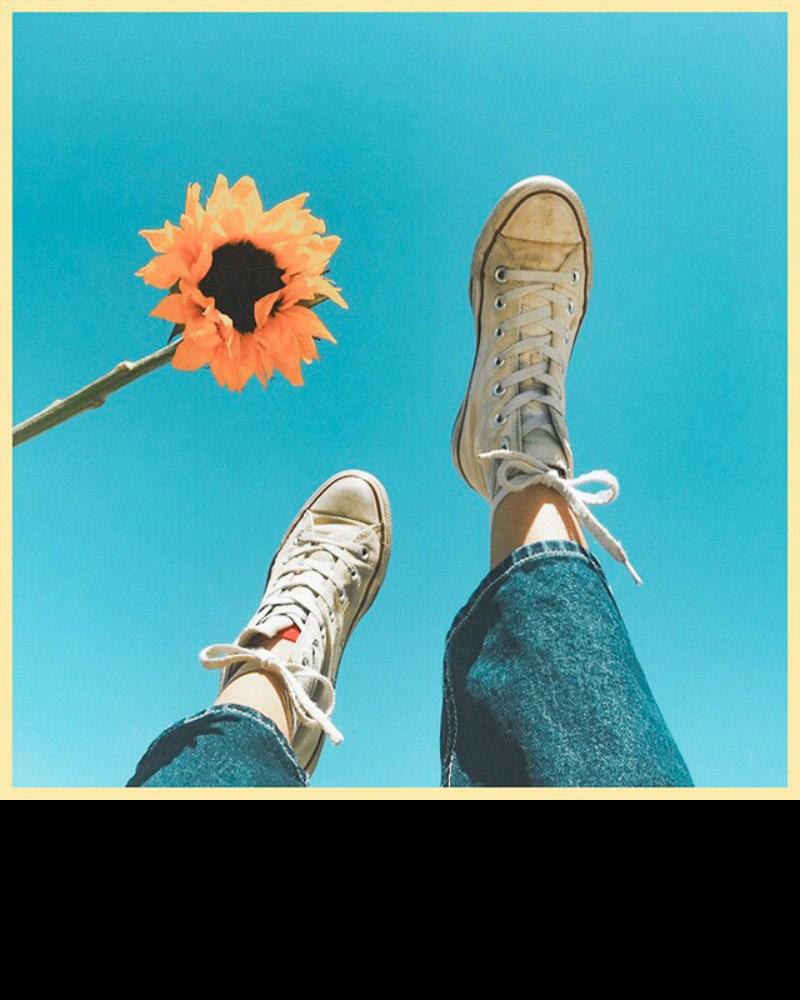
Chapman’s self-designed major is the most exclusive and unique major – one with limitless possibilities.
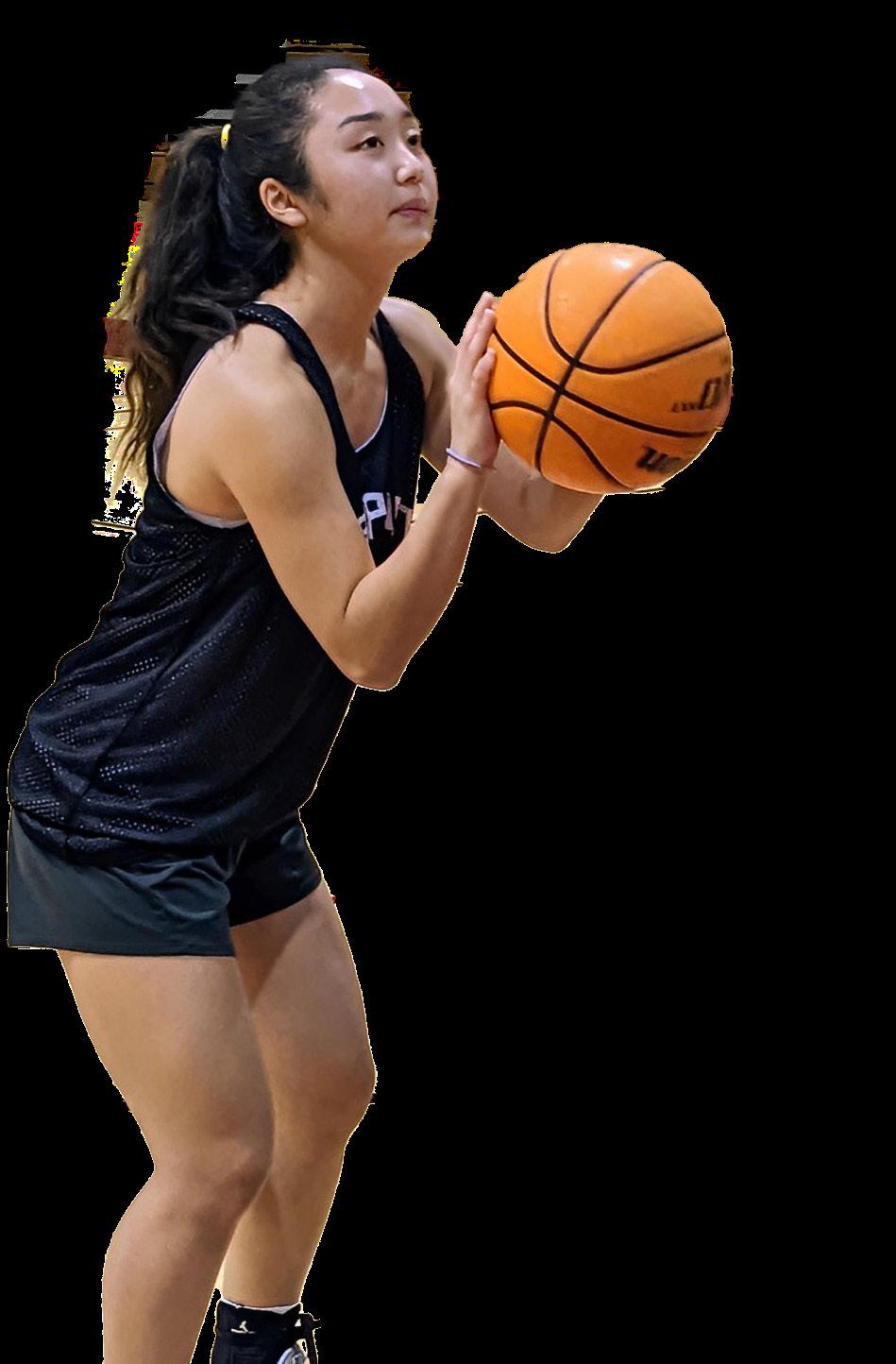
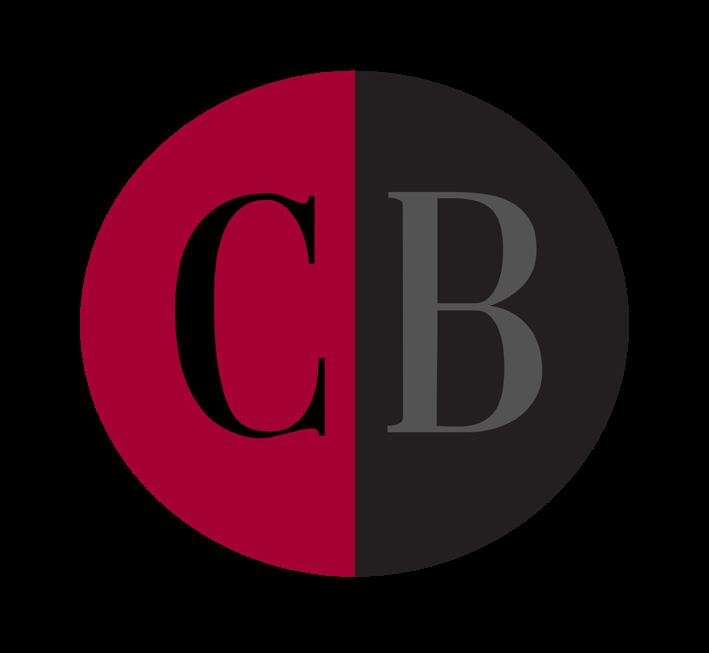
9 (TECH)nically for Everyone: The Tech Shop at Swenson Hall Wants to Get Everyone Involved in STEM
 By Emi Thomas
By Emi Thomas
Want to create anything you can imagine? Now, at an on-campus innovation lab full of 3D printers and laser cutters, you can!
13 Tradition Partition: The Duality of Chapman’s Rituals
By Hazel ThurstonChapman’s long standing traditions of fountain hopping and undie run are unusual and controversial—but nobody seems willing to give them up just yet.
19 A Taste of Life with Long-COVID
By Alexandra Davenport
Life looks different for members of the Chapman population who are still coping with Covid related side effects.
25 Virtual Reality is Virtually Everywhere at Chapman
By Cole Clark
Is virtual reality our new reality? Learn how Chapman is incorporating this technology into learning.
 By Colette Victorino
By Colette Victorino
Chapman’s equestrian team may be missing a crucial member, but spirits remain high.
35 Will
An online mental health resource aims to alleviate high demand at the Student Psychological Counseling Services, but few are using the program. 41 Don’t


By Devon James
Listen to advice from current students on how to make the most of your time at Chapman.
Being a full-time student with a full-time job is a daunting task.
 By Meg Hipp
By Meg Hipp
Student musicians work together at Chapman to create new art and jumpstart their careers.
Attendance requirements at Chapman can be random, unhealthy and unfair. Current students and faculty members weigh in.

The first Asian-American head basketball coach for women’s basketball in the National Collegiate Athletic Association is employed at Chapman—and she’s unstoppable.
Take a deep-dive into Chapman’s education program as recent and soon-to-be graduates explain the hardships they face and goals they work towards as young educators.

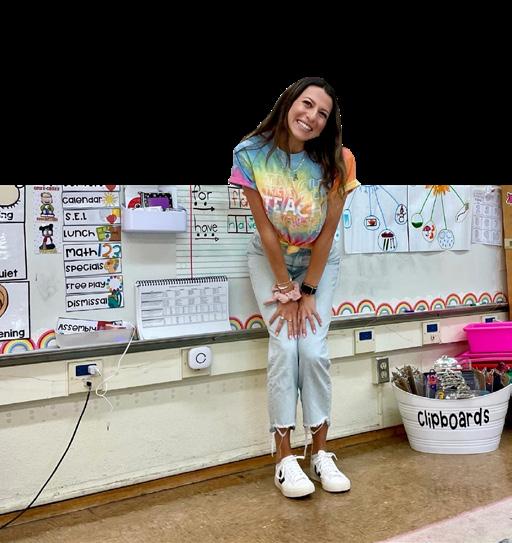
It’s the final issue of the semester.
Did you read that sentence in a somber inner voice or in an excited one? Our bet is the somber one.
People tend to associate finalities with a loss. After all, when something is final, it’ll never be exactly the same again. And you’d be right, to an extent. Sure, after this issue Gary Metzker will no longer be ChapBook’s supervisor, the reporters you grew to love will no longer be writing your stories and Hazel and I will no longer be your editors.
And after this issue is published, I will no longer be a Chapman student.
Graduation is daunting. But it’s a necessity. It’s not a dip-your-toe-in-the-water kind of event; its a spectacular cannonball that turns heads and splashes suntanners.
Everyone is afraid of change. Just ask Gary Metzker. He was faced with the daunting task of supervising a magazine, and despite claiming “I’m just the design guy,” he’s elevated ChapBook into a true, digital magazine that we couldn’t be more proud of.
Change is growth.
The fall 2022 class of ChapBook Magazine has profoundly changed what the magazine is. But the change doesn’t stop here. Next semester I’m confident returning supervisor Jerry Hicks and the new generation of reporters will continue to change and elevate the magazine to places we can’t even begin to imagine.
But back to the magazine before you. All of our stories have one thing in common - they are all stories about change in the Chapman community. We explore what has changed, what people plan to change and what needs to be changed.
And as I write this in my last few days as a Chapman student, I know change is upon me. It’s upon all of us. It’s what makes us better.
So here’s to change.
Sincerely, Adrienne and HazelSketches from a project Spencer Loewen worked on in the themed entertainment club, Bluesky Workshops, which Loewen started himself here at Chapman. Photo courtesy of Spencer Loewen.

Third year and triple major Alexis Reekie came to Chapman with determination, ready to take on her journey in law.
But not just any journey. Her self-designed journey.
“I think it’s really important to take your education into your own hands and make sure that you’re getting out of it exactly what you really want and what you need,” Reekie said.
Self-design majors are an individualized degree program offered here at Chapman that allows students to design their own unique course of study while guided by an advisor.
A charcoal drawing of a tiger and bear (following page) from Spencer Loewen’s ART 124 course, drawing and planning. Photo courtesy of Spencer Loewen.
 By Jaelyn Duran
By Jaelyn Duran
This requires an application process that needs to be approved by the Undergraduate Academic Council.
But…there’s more to it than meets the eye.
And that’s why self-designed majors make-up only 0.24% of all majors and 20 students have self-designed majors out of the 8,199 total majors declared as of fall semester 2022.
The application involves a curriculum map, program learning outcomes and signatures for approval. Chapman’s Vice Provost of Undergraduate Education, Nina LeNoir stresses the importance of the hard work that is involved in the application process.
LeNoir works closely on the technicalities and helps students put together their desired program before submitting for approval. Not everyone gets accepted, but the academic council is there to support students and provide revisions.

“It’s for people who are really serious about doing this kind of work and have a clear plan and reasoning for doing it,” LeNoir said, “It shouldn’t be taken lightly.”
Students must complete 75 credits before submitting their application and it cannot be done in their first year but it is recommended to be done before junior year.

“The reason for that is to ensure that this is an intentional plan that’s not ‘oh I’m taking a bunch of courses I’ve taken and I’m gonna put them together and then I can graduate,” LeNoir said.
Students often face challenges when it comes to signatures because they need one from every department that they have courses in. LeNoir also said that changes with staff and courses impact course plans.
“If I could talk someone out of it, I would because it’s number one, a lot of work and number two, things change” LeNoir said, “So if things change, you’re kinda stuck…that happens in majors too, but for the self-design major every change has to go back to the academic council to get approved, so there’s always something.”
When asked if there is more opportunity or career benefits compared to traditional majors, LeNoir simply shook her head no.
“It might make you look a little interesting, but if they don’t understand what you did, it might disadvantage you so I think it has to be somebody who has a passion and is willing to do the work,” LeNoir said.
Reekie, a triple major in philosophy, political science and law and liberal arts, was ready for that work.
Knowing she wanted to triple major, she took the step to turn the law and liberal arts minor into something bigger with the self-design program.
“It’s definitely been an interesting topic to discuss…I get to talk about this major and how creating it was really important for me to have different perspectives on the law,” Reekie said.
Reekie’s application took seven months to get full approval. Because her courses include nine different disciplines, getting signatures from each of the department’s deans was difficult for her.
“It was a lot of back and forth,” Reekie said, “I would do all the things that are needed and then get a response that there was something else that I needed to do and it took a really long time so when it finally worked out I was really excited about it.”
Graduating this upcoming spring, Reekie’s next step is to attend law school and end up in corporate law upon finishing graduate school.
Self-design majors allow the opportunity to expand an already created minor like Reekie with law and liberal arts or students can also bring something new to the university.
Senior double major Spencer Loewen did just that with his self-designed major of themed entertainment design. Initially, Loewen said family and advisors brought doubt to his decision by saying “no one cares about it” or “it’s made so that you can fail” but none of this stopped him.
Instead, it made Loewen work even harder.
“Being told no just motivates me,” Loewen said, “I’m like ‘okay I want to do it even more and I’m going to work harder to make it happen’ so doubting it eventually helped me but there were definitely mental breakdowns.”
Spencer Loewen painting a ceramic giraffe done in ART 115 foundations in ceramics. Photo courtesy of Spencer Loewen.
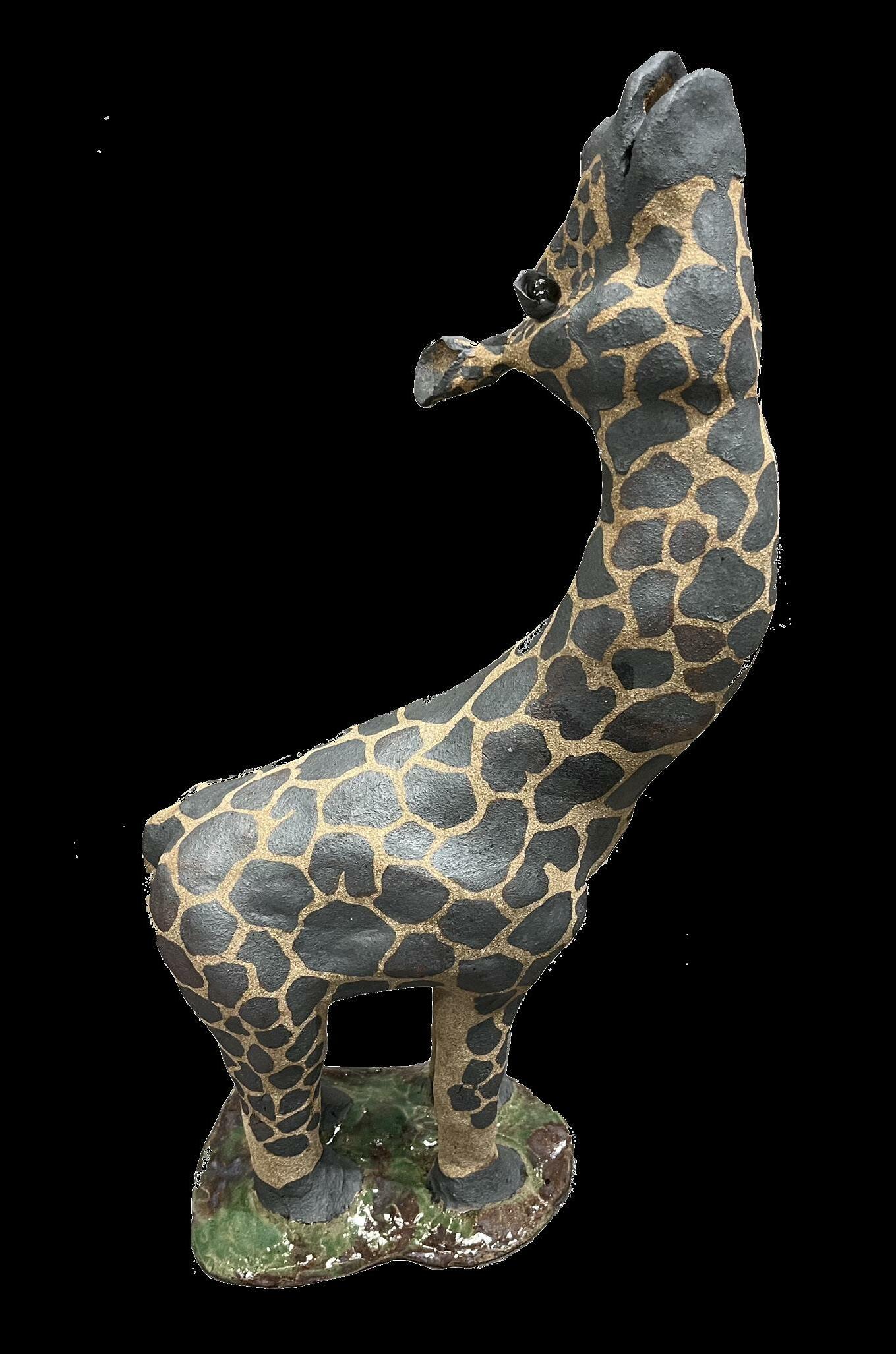

Loewen wants to work on the creative and design teams who build theme parks, escape rooms, zoos and museums. In order to do so, Loewen chose courses from four departments: creative writing, anthropology, art and theater tech.
After countless Zoom meetings and emails with departments, Loewen was ready to finish his application until the form went under revision. He had to transfer his plan to the new version, and after a year, was finally approved during his second semester of sophomore year.
“I remember I just ran out of my dorm room and just like ran down the street,” Loewen said, “It was a very surreal and strange moment…the weather was weird too it was like half rainy half sunny and I was just like ‘what is life’, and then I realized I had a Zoom class in like five minutes and ran back to my dorm room.”
Ready to put this major to work, Loewen currently works in a site department for Walt Disney Imagineers. Loewen also said it has been helpful in setting up informational interviews with imagineers and designers from different companies and theme parks.
“The people have told me because of that [major], I’m much further ahead than other people would be so it’s been a helpful thing to have,” Loewen said.

A ceramic snake mug made and painted by Spencer Loewen in his foundations of ceramics course. Photo courtesy of Spencer Loewen.

When asked if he would recommend the self-design program to incoming students, he said he would and added that students have to be ready for it and willing to put in the work to make it happen.
“If
19 other people, absolutely go for it,” Loewen said, “Just be ready to defend your reasons why and work like hell because it’ll pay off.”
Chapman will continue to revise the application process to be easier to understand, but also stresses the importance of intention in applying.
A Spelling Bee scene sketch done by Spencer Loewen in TH 387 scenic design for a production. Photo courtesy of Spencer Loewen.

you’re in a situation like me and I guess

The famous Chapman University saying that we’ve been hearing since we set foot on campus has become a motto to live by in Swenson Family Hall of Engineering’s Tech Shop. There, students use state of the art technology to create anything imaginable.
The Tech Shop opened along with the Swenson Family Hall of Engineering in the Fall of 2021. Inside, you’ll find a variety of machines to use, including 3D printers, laser cutters and more. It is funded along with the rest of the hall’s facilities by a $5 million gift from the Swenson Family Foundation, according to an earlier Chapman University article.

With a team of student workers and their manager, Carlos Vergara, the Tech Shop has hosted a variety of workshops in an effort to teach people about the different machines available to them.
The student workers at the Tech Shop are in charge of hosting the workshops. “Whatever idea they have we encourage them to research it and teach what they learn to everyone else by hosting a workshop. I employ about six student workers and each of them has to research something they are interested in and host a workshop around that,” Vergara said.
Previous workshops have included laser cut acrylics that light up with a design of each student’s choosing and 3D printing a custom chocolate mold. Upcoming workshops include a Design Your Own Skate Deck workshop and jewelry making workshop. Both of these events have yet to have a date set for them.
(Left) Sarah Fieck, a student worker at the Tech Shop, uses a 3D printer.

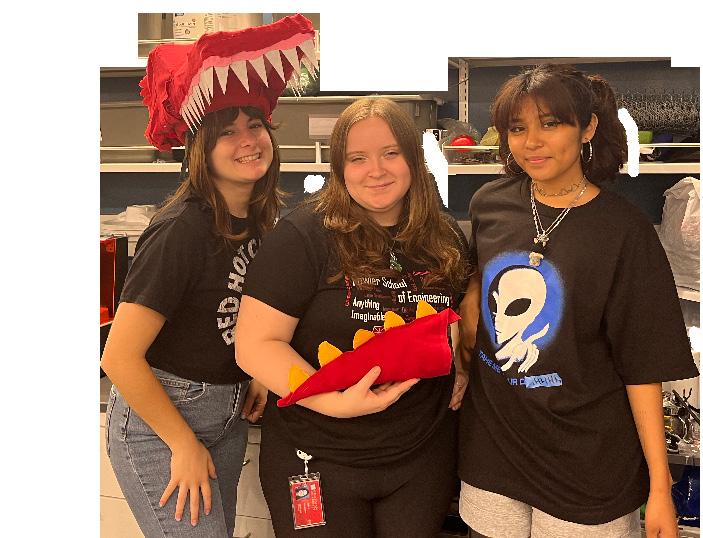

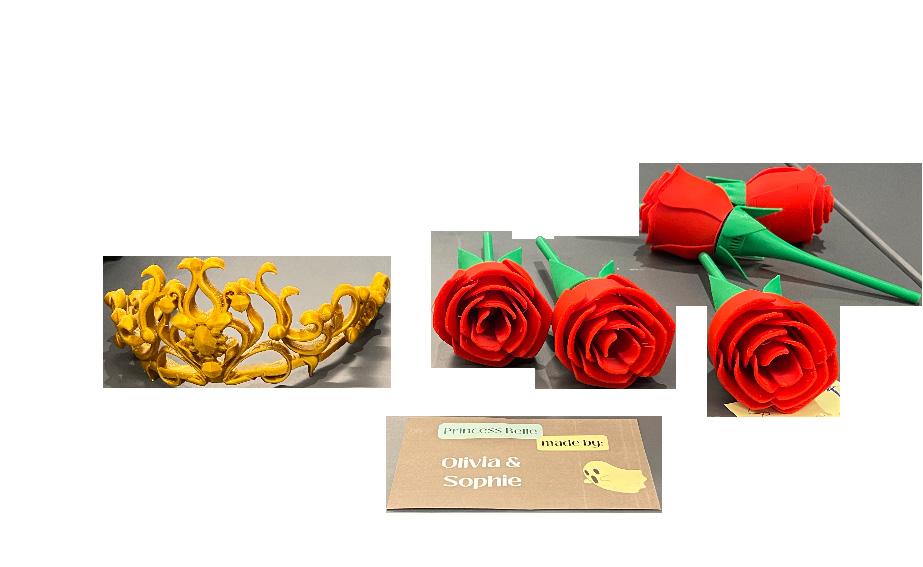


Universityof Alabama shouts ‘Roll Tide’ at sporting events. Stanford has its infamous tree mascot. And Chapman… has students swimming in fountains and running around in their underwear?
Evelyn Harding, an undeclared freshman, described her experience with one of Chapman’s only unique traditions on campus. “I’ve heard of fountain hopping,” she said. “[It’s] basically, you know, like dunking in every fountain on campus at night. I did it on my own with a few friends.”
For Harding, Chapman was the right fit location-wise. Events, culture and community weren’t a major draw. “School spirit is pretty moderate,” she said. “People are involved but they don’t prioritize it, I guess. It’s not a huge thing.”
She completed the fountain hopping challenge early on in her college career, a rite of passage for many students. Finding out about the unique choice to bathe, fully clothed, in every body of water on campus wasn’t too hard for Harding. “During the fenestra forums our [orientation leaders] talked about it briefly,” Harding said. “And I’ve also heard it through
word of mouth because there was a huge group of people doing it.” But in terms of getting involved in school traditions, that’s where it ends for the incoming freshman class.
“Other than [fountain hopping] I don’t know of any particular traditions. But I’m sure I’ll learn more about that the longer I’m here,” Harding said.
Byers, a third generation Chapman undergraduate student, is currently completing her masters degree in Curriculum and Instruction after graduating with a bachelors in English Literature and Rhetorical Studies earlier this year. Her family’s dedication to the university made getting involved important to Byers. “Even though they’re usually targeted toward freshmen or seniors as their final hurrahs, I think it’s those small and silly traditions that make Chapman feel like a community,” Byers said.
Similarly to Harding, Byers completed the fountain hopping challenge her freshman year. She heard about it during orientation week, where fountain hopping was heralded as a tradition passed down from previous
Byers completed the fountain hopping challenge her freshman year. She heard about it during orientation week, where fountain hopping was heralded as a tradition passed down from previous generations of students.
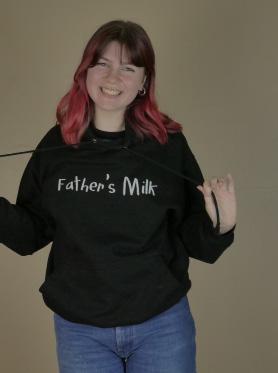
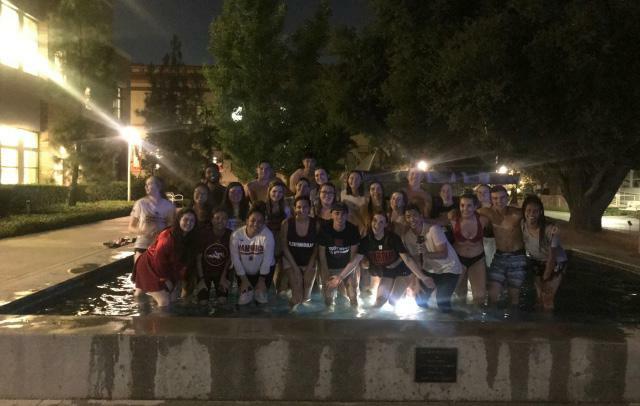
“Even though the actual event of fountain hopping wasn’t super fun, it’s the memories that I look back fondly on every year, especially when I get the photo memories and videos on my phone,” she said.
Culture, traditions and the Chapman community have shifted through the years. For returning graduate students, tenured faculty members and upperclassmen, Chapman looks different.
Morgan Read-Davidson, a two-time Chapman graduate and current Director of Undergraduate Writing Programs, described how his experience with the university has changed over the last 20 years.
Students participating in fountain hopping. Photo courtesy of Adrienne Mitchel. A picture of freshman Evelyn Harding. Photo courtesy of Harding.“That Chapman that I attended was much different than the Chapman I know now,” he said. “I think when I was here it was like 3,000 undergrads and now it’s almost 10,000 [students total].
When I went to film school, it was in DeMille. It was on campus. My culture was the film students I was making films with.”.
The lack of unified campus rituals is not necessarily a bad thing for Read-Davidson, however.
I think those memey “I think those ‘meme-y’ ways of distilling university culture down into this mascot or something are pretty harmful for a lot of students,” he said. “The great thing about Chapman is that there isn’t so much that idea of conforming.”
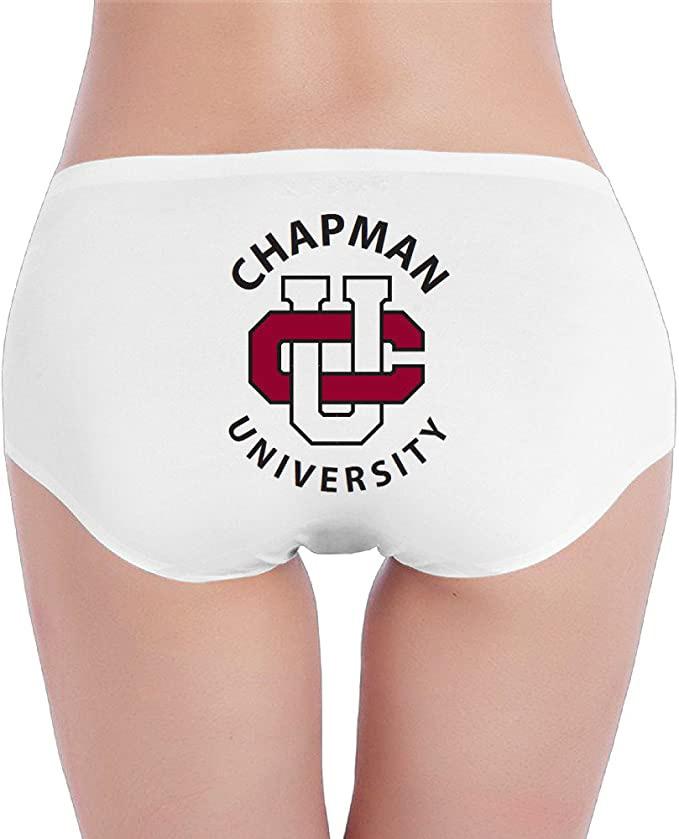
Read-Davidson acknowledges that Greek Life, and its events, might be contributing to the general campus culture in a way that it didn’t when he was
an undergraduate in the early 2000s. By the time he returned as a faculty member, the amount of affiliated students was surprising to the professor.
“When I was [a student] at Chapman, Greek life was almost nonexistent,” he said. “When I [was hired by] Chapman in 2011, I was really surprised because it was like 40% of the student body in Greek life.”
For other graduates, how-
ever, Greek life was a major, positive part of their overall experience and Chapman’s university culture.
Steele Viverette is a fall 21 graduate and currently works as the Welcome Center and Virtual Experiences Coordinator for Chapman’s Office of Admission.
He accepted a position with Chapman after working a variety of public image-related jobs for the university as an under-
I think those memey ways of distilling university culture down to its mascot or something are pretty harmful for students,”
- Morgan Read-DavidsonA pair of Chapman University low-waist underwear, available on Amazon. Photo courtesy of amazon.com.
gradute at Chapman.
For Viverette, Greek life was an important part of his university experience, despite being unaffiliated himself. He has always insisted that sorority and fraternity culture at Chapman brings people together instead of dividing them.
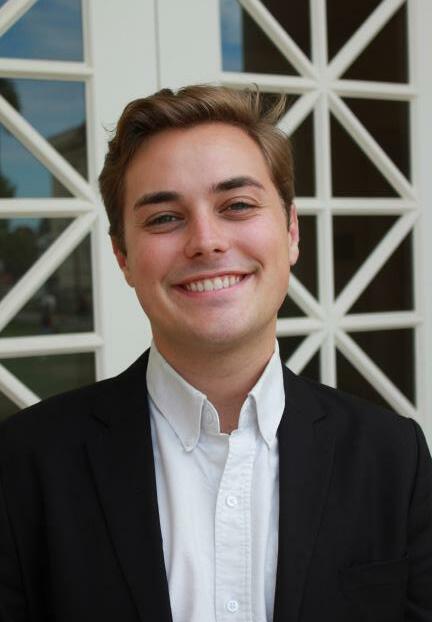
“When people ask me about my favorite part about Chapman, my answer is always community, Viverette said. “And I think that is because our students are so involved and because there are so many traditions and events people get excited and involved in.”
Viverette can, however, acknowledge that the ap-
pearance of Chapman has changed since Covid.
Chapman’s Undie Run, a biannual finals week event where students dress down to their undergarments and run through the streets of Orange, was adopted from UCLA before Viverette even attended Chapman.
“My first undie run was a pre-Covid undie run and it definitely did look different upon its return,” he said. “My first semester you ran all the way around the actual fountain of the circle. I think this last semester they cut it off before you even got past the Filling Station.”
But Covid isn’t the only reason that Undie Run’s longev-
ity is suffering. Part of the restrictions, of course, may be due to the university’s and student population’s perception of the event.

Jane

“UndieAn image of Jane Simonetti (‘23). Photo courtesy of Simonetti. A photo of Welcome Center and Virtual Experiences Coordinator Steele Viverette (‘21). Photo courtesy of the Office of Admission. A head-shot of Morgan Read-Davidson. Photo courtesy of Read-Davidson.
“[Undie run] is a very weird Chapman tradition,” she said. “The things that make undie run bad are the people who use it as an excuse to sexually harass and assault [those] who are participating.”
It’s pretty obvious: a bunch of inebriated teenagers running through the street in their tighty-whities isn’t a great look for Chapman.
“There has always been pushback from the University obviously not wanting [undie run] to happen,” Viverette said. “I think Covid was an opportunity [to decrease the amount of participants] because everything was rebuilding [and that] was the perfect chance to restrict it.”
But for Simonetti, the minor controversy surrounding undie run goes beyond university reputation or aesthetics. The finals week event is potentially dangerous.
Simonetti admits that the administration discourages participation in undie run, but also points out that there’s zero oversight from Chapman.
“I personally was not assaulted or harassed. But I’ve heard of people who have been,” Simonetti said.
It’s easy to turn a blind eye to a tradition that isn’t technically university sanctioned. If it’s not Chapman’s event, then it can’t be Chapman’s problem. And undie run is not highlighted the way that fountain hopping is.

The evening of Chapman’s Winterfest 2022. Photo courtesy of senior Allison

“When [I] think about Chapman traditions, I think about WinterFest, Airbands, Spring Sizzle. . . those things come to mind for me before I think of Undie Run or Fountain Hopping,” Viverette said. “I think they garner a larger crowd from a more diverse set of people. WinterFest brings together students, it brings together alumni, it brings together faculty, it brings together community members.”
Morgan Read-Davidson can agree.
“I think we do have to acknowledge that Chapman is a part of this community,” he said. “I have noticed, in the last few years, that the level of interest in engaging the community has declined drastically. The charm of Chapman is that it is in Orange.”
According to Read-Davidson, the community’s reservations with on-campus traditions are mostly due to concerns about the student body living off-campus. Increased enrollment leads to more disruptive upperclassmen living next to—and potentially causing issues for—Orange locals.
For Viverette, however, involving the community is one of his favorite things about Chapman’s dedication to continuing tradition and culture for students. To him, the success of various programs hosted by Chapman is an homage to his legacy post-graduation.
“Spring Sizzle has a special place in my heart,” he said. “I actually, as a student, worked Spring Sizzle because I was in University Program Board. I still remember my days scooping popcorn for people, so it’s kind of cool to go back and see how it’s grown and see the current students there working it, and enjoying it, because I can see myself really specifically there as a student too.”
its place as a positive force within the university.
“Speaking from my perspective, there’s kind of this dichotomy. It is not necessarily, outward facing, a great look having a bunch of people running in their underwear through the city,” he said. “But there is also this aspect where it is a big Chapman tradition. It brings people together. The students look forward to it. It’s part of our culture at this point, whether or not that’s something that the university is proud of. It’s here and it’s here to stay.”
A grad photo of Brie Byers (‘22). Photo courtesy of Byers.

Brie Byers agrees.
“
And even Undie Run, Viverette admits, has


These traditions, whether university backed or not, are what make Chapman, Chapman. And just as Viverette said, there’s one thing clear: they’re here and they’re here to stay. These traditions, whether university backed or not, are what make Chapman, Chapman. And just as Viverette said, there’s one thing clear: they’re here and they’re here to stay.
IT’S THOSE SMALL AND SILLY TRADITIONS THAT MAKE CHAPMAN FEEL LIKE A COMMUNITY AND UNITE PEOPLE FROM DIFFERENT BACKGROUNDS TO COME TOGETHER AND HAVE AT LEAST ONE SHARED
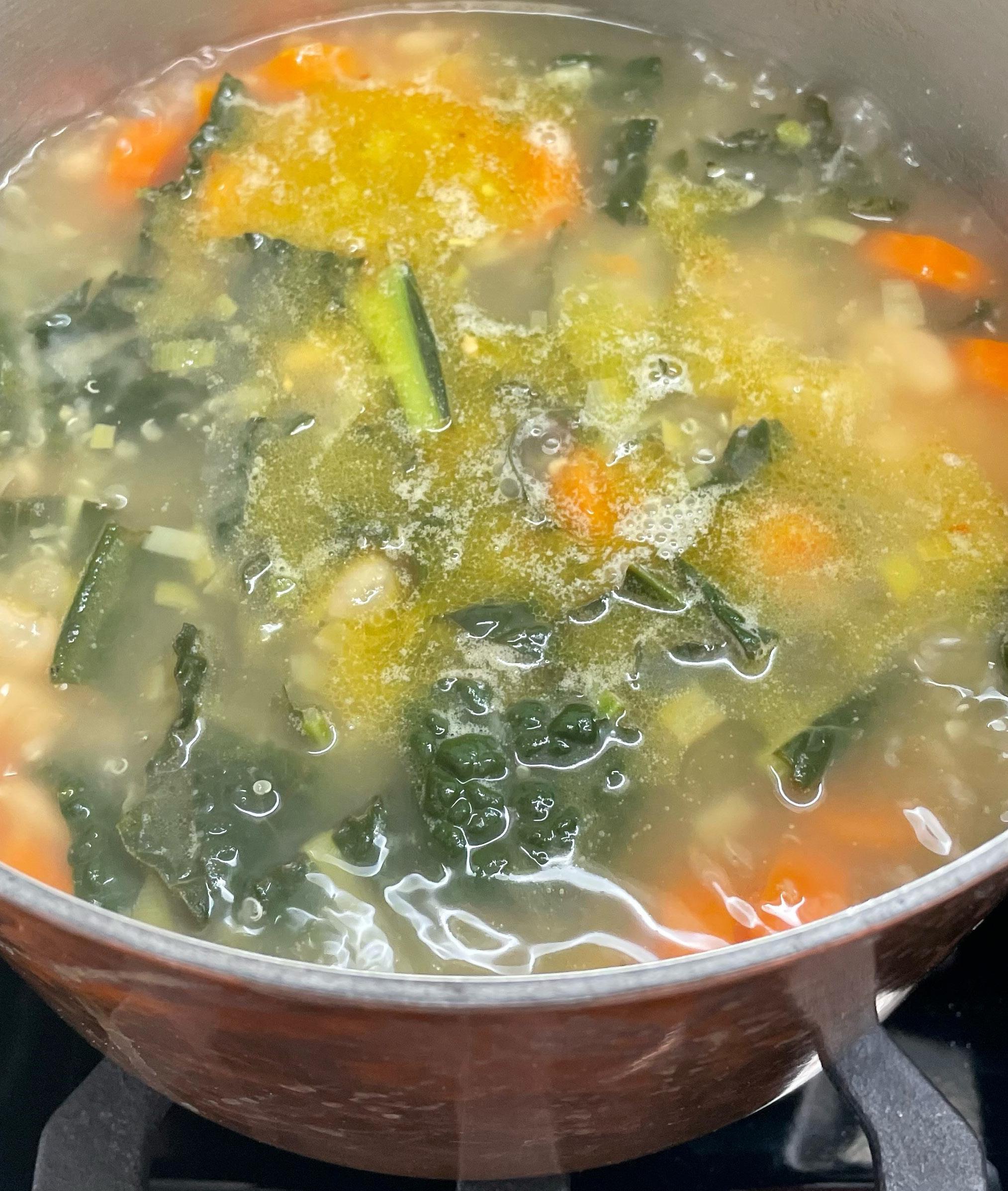 A flavor of soup her mother made while Mary Bush was home with COVID-19 in January 2021. Photo courtesy of
A flavor of soup her mother made while Mary Bush was home with COVID-19 in January 2021. Photo courtesy of
January 2021, while senior Mary Bush was home with COVID-19 , she dipped a piece of French bread into a pot of her mother’s homemade tomato soup, but was surprised when it was completely bland.

She had lost her taste and smell, common with the virus. After her other symptoms got better, weeks went by and her two senses didn’t come back.
Today, almost two years later, Bush still can’t taste or smell.
“I was like, ‘it’s fine it’ll come back,’ and then it didn’t,” she said.
Everyone knows someone who’s had COVID-19, but there is a group of Chapman students facing what feels like never-ending maladies, called longCOVID.
The Centers for Disease Control and Prevention (CDC) defines long-COVID as on going health problems after having severe cases of COVID-19. There are no immediate answers or solutions to living with long-COVID, but that there are prevention strategies and ways to improve symptoms.
Jeff Goad, professor of pharmacy at Chapman, said that the population most at risk is young adults.
Chapman’s Rinker Campus has funded a Neuro-Deficit Clinic through 2024, which focuses on people who have long-COVID issues. This includes those related to memory, attention, fatigue, word-finding or communicational problems, according to Mary Kennedy.
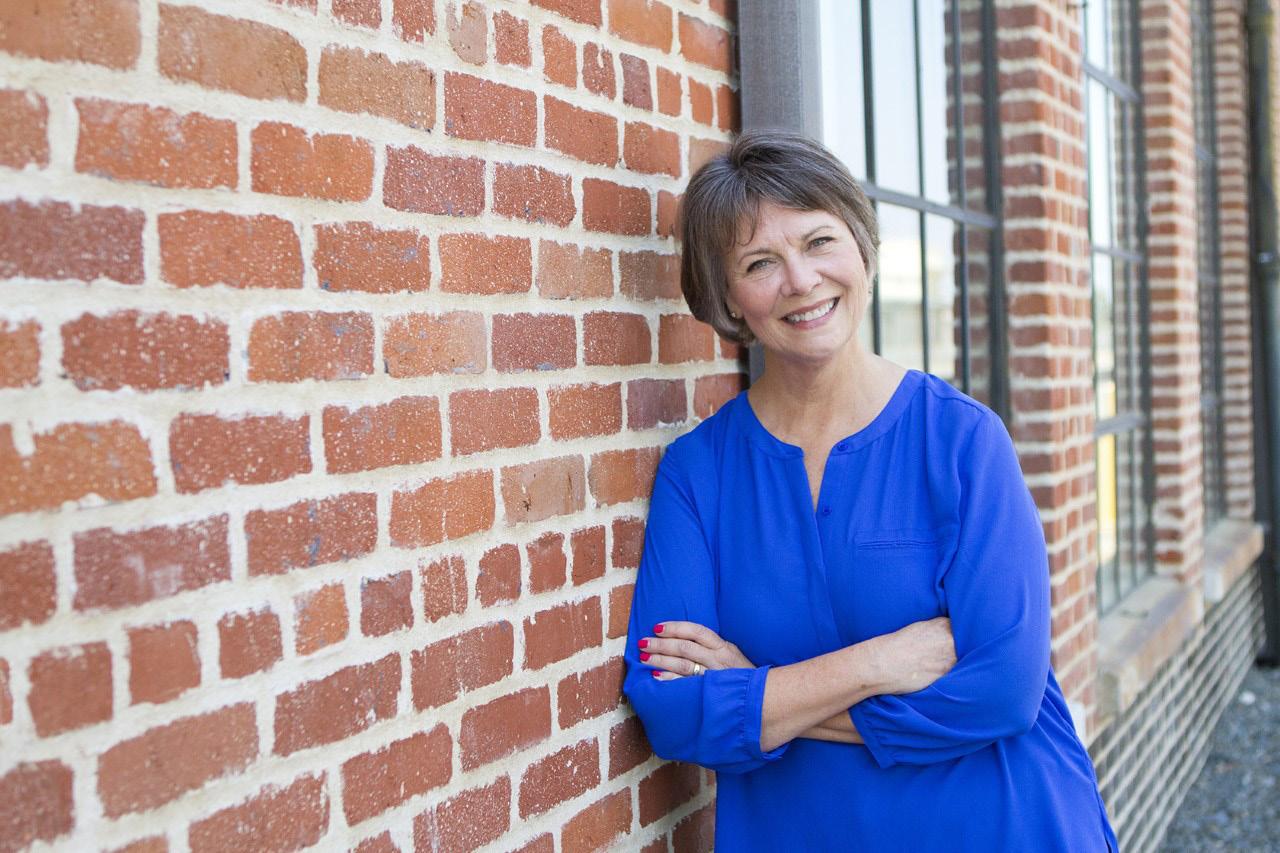
She said it can be challenging to differentiate if people have long-COVID, which is why coming in for an evaluation is important. When patients have multiple long-COVID symptoms, like respiratory or major organ issues and cognitive issues, Kennedy said the clinic refers them to a comprehensive clinic to provide necessary services.
“The first step in advocacy is setting up an appointment,” she said.
Crean College of Health and Behavioral Sciences received a gift to support the clinic in 2021 after applying for funding in 2020. The Rinker Campus clinic has had contact with about 25 individuals with long-COVID.
Mary Kennedy, Chapman professor who specializes in cognitive rehabilitation. Photo courtesy of Kennedy.As more young adults find out they may have longCOVID symptoms, Kennedy wants to get the word out and promote the clinic’s services. She’s been on the radio and posted information by Wilson Field.
“I would love to see some Chapman students and faculty,” she said.
While Bush is facing the loss of her taste and smell, other students are enduring different long-COVID symptoms.
Ella Kodjababian, a senior communications major, has felt like she’s had COVID-19
Ella Kodjababian pictured sitting in a lung specialist’s office in Seattle hoping to finally understand why she couldn’t breath the way she used to. Photo courtesy of Kodjababian.
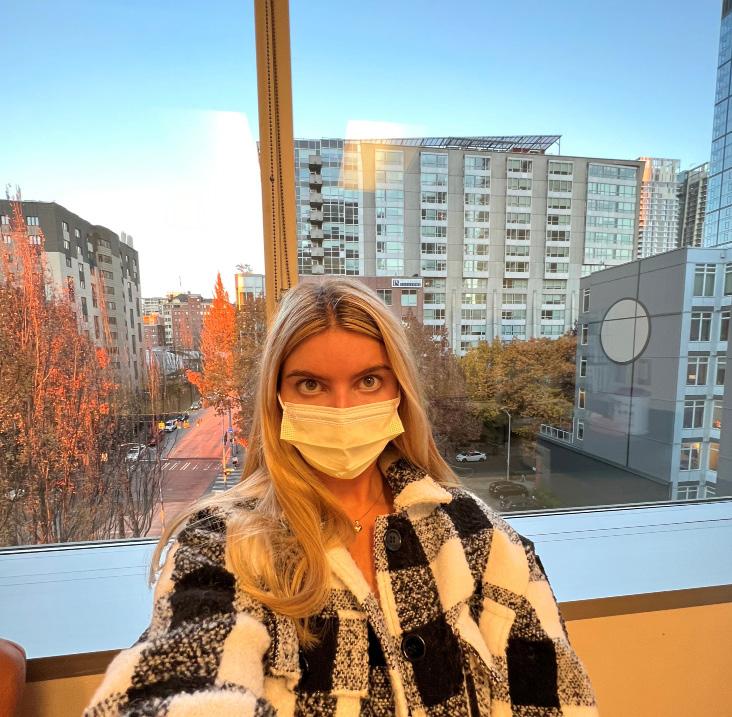
Before she was vaccinated, Kodjababian had COVID-19 for the first time in 2020. After having the virus three times, her trouble breathing got worse and didn’t go away.
“I felt so sad and defeated, cause I’m like, ‘again? I’m getting sick again? Can I just have a normal life when I’m just healthy, like how I used to be?’” she said.
Last summer, Kodjababian was deferred to a lung specialist, who diagnosed her low antibody count for fighting upper-respiratory infections. Along with a steroid shot, the specialist gave her three inhalers to use twice a day.
She used to be on Chapman’s track team, but quit this year.
“Last season I was just sick the whole time, and it was hard for me to breathe during the workouts,” she said.
Kodjababian said she wouldn’t be surprised if she’d have to live with asthma and inhalers.
Some students, like sophomore Kaiya Shivers, have seen their friends suffer long-term after having COVID-19.
Shivers, a theater performance major, felt fatigued and lost her taste and smell when she had the virus in March 2021. Her symptoms lasted a week, which is normal, according to the CDC.
Shivers felt lucky.
Her high school friend was not as fortunate and lost her taste and smell for months.
“Chocolate and coffee started tasting like onions,” she remembered about her friend.
Goad said to observe the difference between symptoms when someone first gets infected and what happens after that period to determine when long-COVID could be present. He said fatigue and shortness or breath are common, and that loss of taste and smell long-term is rare.
According to Goad, strategies to improve long-COVID symptoms include person protection strategies and getting vaccinated. CDC data shows that people who have been vaccinated against COVID-19 are less likely to develop long-COVID. Goad the vaccine is dose dependent, meaning people are more protected with more doses. Less severe cases of COVID-19 mean lower chances of getting long-COVID.
As for Chapman University Student Health, director Jacqueline Deats said that long-COVID is in the discussion at staff meetings although no one, to her knowledge, has come in seeking help with long-COVID symptoms.
“We are rolling with the punches, and if this is our next thing that we have to tackle, then we will be ready to do that,” she said.
Harold Hewitt, chief operating officer for Chapman, has chaired Chapman’s COVID-19 Task Force since March 2020. The Task Force is a group of experts that works to keep campus well-informed and prepared and updates the CU Staying Healthy website, which provides recommendations and data concerning trends in Orange County.
“We’ve
he said.
Kennedy encouraged Chapman students who are concerned they might be facing longCOVID symptoms to reach her by phone or through the Neuro-Deficit Clinic website.

Although Bush can’t quite remember the smell of her favorite flowers, after living years without her taste and smell, she’s getting used to it. She still hopes she’ll be able to smell her mother’s cooking when she visits home.
“It’s kind of become my normal now,” she said. “I hope it comes back though.”
Senior Mary Bush on a trip to Paris, still traveling and getting back to normal though she lives with COVID-19 repercussions every day. Photo courtesy of Bush.
tried to make it easy for people who want to be informed,”

Credit: AdobeStock.
By: Cole ClarkWhen you think of “virtual reality,” what images pop into your head?

Perhaps headsets or someone filming themself playing a horror game in an immersive world. Matt Favela, president of the VR/AR Club at Chapman, thinks of it like “the early days of the iPhone, where it’s all very new, and everybody wants to give it a try.”
VR is a popular buzzword, but it remains a new technology, and Chapman’s involvement with it is still being defined.
Chapman professor Madeline Warren sees potential for film. “Filmmakers are using VR to previsualize set design, camera placement and blocking,” she said.
Meta Quest Headsets are provided for students who take a VR/AR class at Dodge or participate in VR/AR Club. Courtesy of Matt Favela and Michelle Ballesteros.

Chapman’s recent purchase of an LED wall (the same technology used for 2022’s “The Batman”) allows production teams to project scenes and backdrops on a large digital screen before cameras ever start rolling.
“I’m thrilled to see students using the LED wall to film scenes that would be too expensive, unsafe or difficult to accomplish in a practical location,” Warren said.
Developing for VR is clearly a focus at Chapman, but the experience itself is drawing students in.


 – Charles Fink
– Charles Fink
 – Austina Wang
– Austina Wang
 By Colette Victorino
By Colette Victorino
*Editor’s note: The writer was previously on the Chapman Equestrian team but she is currently not associated with the team.
Barrett Whitesell soaring over a jump while competing with her horse Pie In The Sky. Photo courtesy of Stephen WhitesellJunior Isabella Meagher was shocked when asked if she knew about the university’s club riding group.
Students and faculty are most likely surprised when someone mentions that Chapman has an equestrian team and are often confused as to what the team actually does. The team competes against other schools such as USC, UCLA, UC San Diego, Cal Poly Pomona, ASU and University of Arizona in competitions that are spread throughout the school year. However, with no coach this year, the team is unable to compete and is unsure of their future.
The previous coach, Lisa Rathfelder, had to take a break from coaching due to personal reasons. Rathfelder enjoyed coaching the team and had even planned to keep coaching the team when she retired.
Rathfelder’s full-time job is coaching and training others at her own barn Andiamo Equestrian located at Sycamore Trails in San Juan Capistrano.
“There was too much on my plate, and I didn’t feel that I would give the team what they deserved,” Rathfelder said.
Even though Rathfelder made the decision to leave the position, she is really upset that the team couldn’t compete.
“I feel horrible and am so sorry,” Rathfelder said.
Rathfelder had even bought two new horses for the team to use but is unsure if she’ll return next year to coach the team.
Like Rathfelder, team president Faith DiMaria also wishes that the team was able to compete this year. DiMaria, a junior majoring in health science, has been riding horses since she was 3 years old and has been competing since she was eight.

Although she is ready to come back next year, DiMaria misses competing and spending time with the team while at competitions.
“This year we were supposed to have six competitions, but complications with our coach means we will not be having a competing team this year,” DiMaria said.
In the past, the team would arrive at the competition around 6 a.m. and take care of their horses. Each competing school brings a few horses, and the riders pick a horse’s name at random. When it’s time to go compete, they get on their drawn horse and immediately go in -- which is hard because they’ve never ridden the horse before.
Outside of competitions, team members are required to take lessons, either from the Chapman team coach or their own personal coach, in order to stay consistent in their riding.
Team captain Barrett Whitesell had similar thoughts to DiMaria when it came to spending time with the team while at competitions.
“Being on the team is super fun and definitely worth it,” Whitesell said. “You get to spend time with a lot of great people who share a common interest.”
“Horse shows are the most fun part of being on the team,” DiMaria said.
Each rider competes in their respective divisions against riders from other schools and that they receive placings at the end of each class. The team spends the day together while caring for their horses and cheering on their teammates.
Whitesell, a senior majoring in environmental science and policy, has been riding horses for 12 years and is now captain of the team for her final year at Chapman. Throughout her years of being on the team, Whitesell noted that a lot of people don’t know about the team because of how small the team is.


“Probably because we’re a club sport, we don’t get much recognition,” Whitesell said.
(Left) Team member Angelina Thalheimer showing off her first place ribbons after a weekend of competing in Arizona in Feb. 2022. (Right) Team president Faith DiMaria posing with her horse Virtue. Photos courtesy of @chapmanuequestrian and Ashleigh Magnus Photography
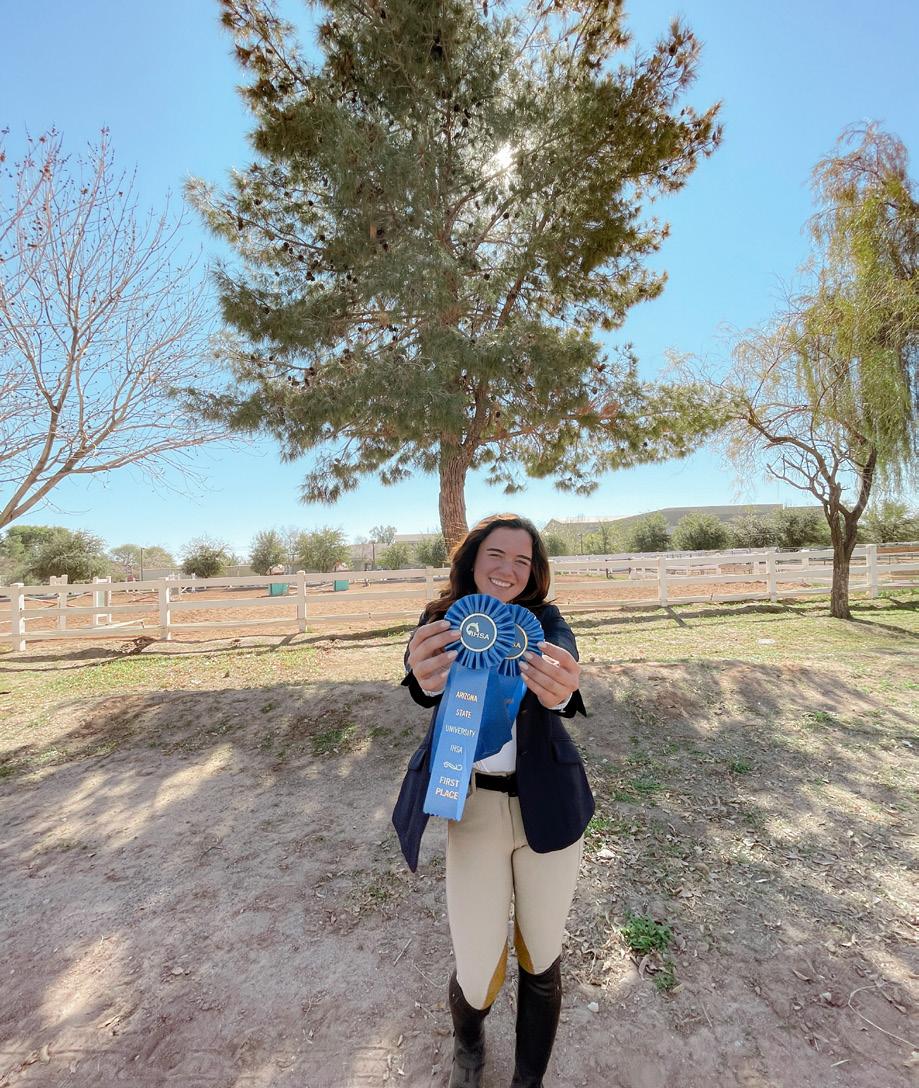
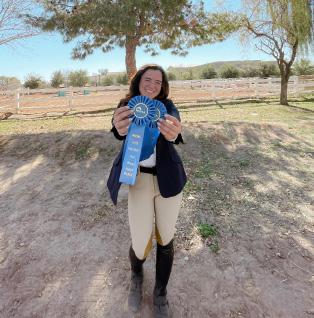
(Top) Candid of the team during team photos of Spring 2022. (Bottom) The Chapman Equestrian Team after a weekend of competing at Hansen Dam Horse Park in November 2021. Photos courtesy of @chapmanuequestrian on Instagram
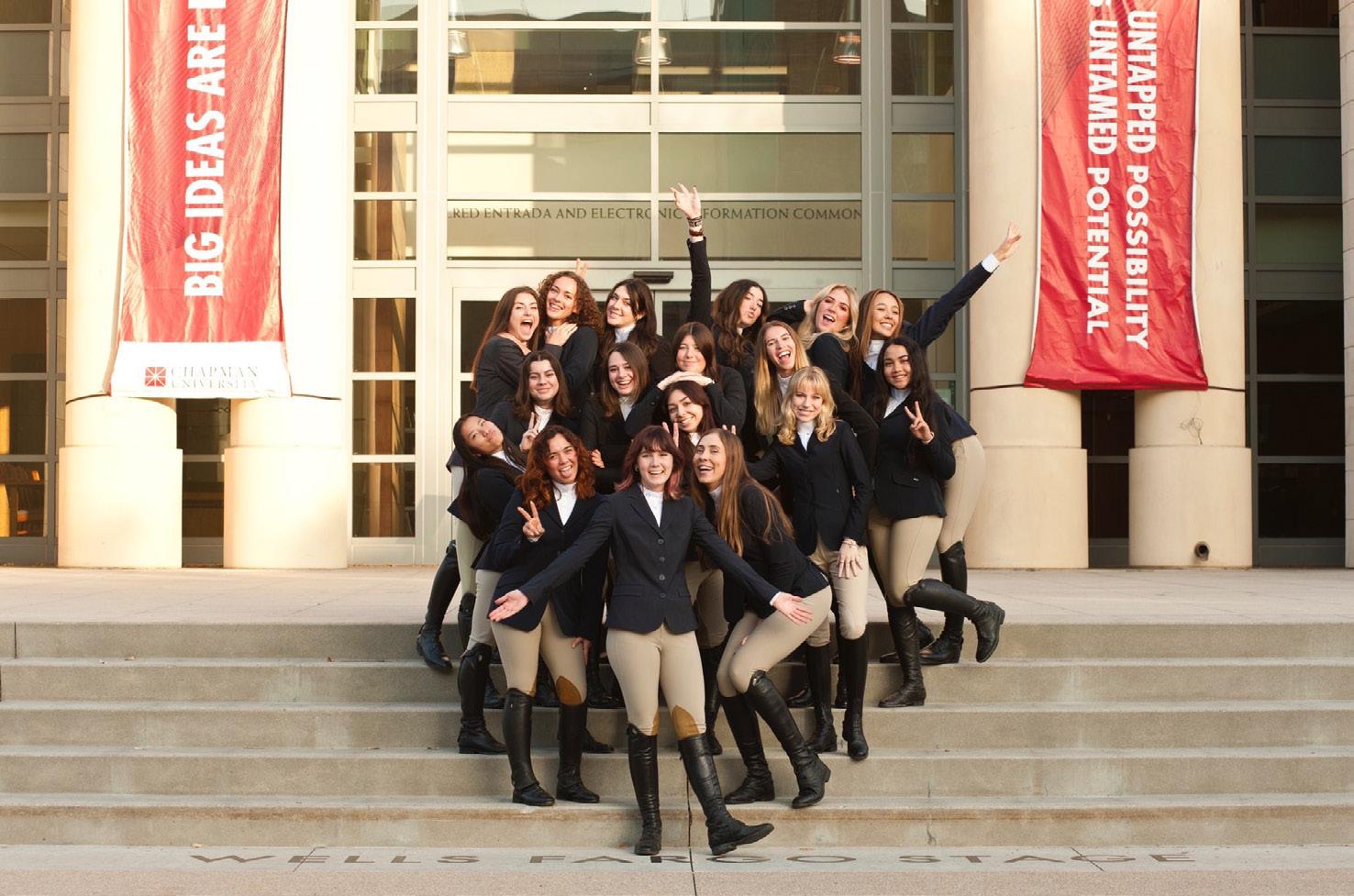
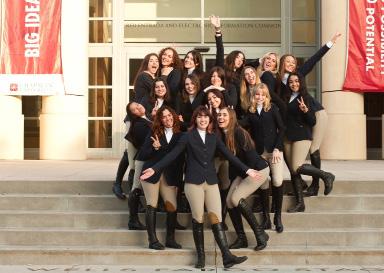
“We also have a small team of usually around 15-20 people. There also isn’t much promotion around campus and our competitions are off campus as well.”
Equestrian team member Angelina Thalheimer agreed with Whitesell and is shocked when people actually know about the team. Thalheimer, a sophomore majoring in psychology, has been riding since she was 6 years old.


“I learned not to care anymore since the school barely recognizes us,” Thalheimer said. “It’s hard to get the word out there about the team when no one even knows that we have one.”
Both Whitesell and Thalheimer say that the team does not get the funding that it deserves, as they were given more in the past despite being a club sport.
“This year we tried putting fliers around campus and it worked pretty well,” Whitesell said. “we’re going to try getting a table at the club fair next year or something like that, but most people find us through our instagram @chapmanuequestrian.”
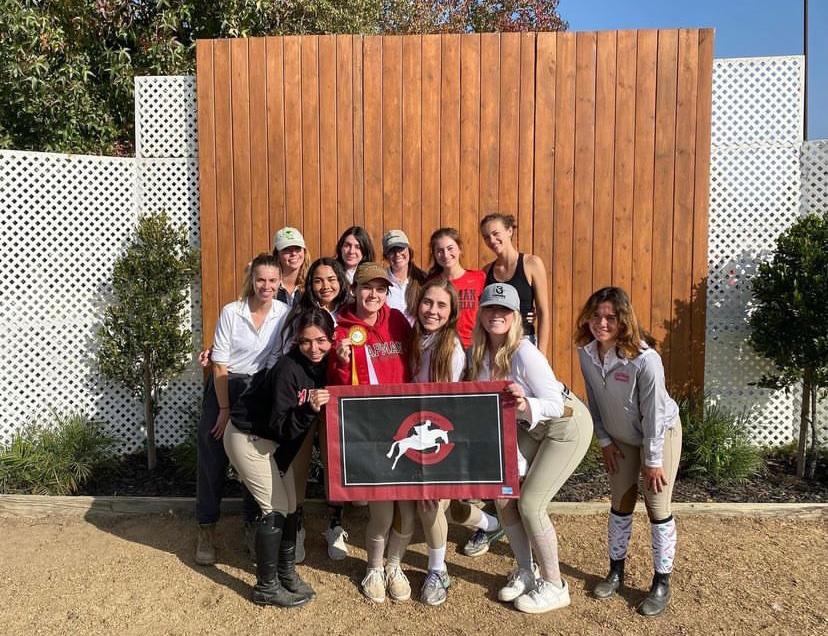
Despite the fact that the team is unable to compete this year, Rathfelder said that “the team can definitely be successful in the future,” and that she would definitely consider coaching the team again.
At this time it is unclear whether Rathfelder will come back to coach the team or if a new coach will be needed in order for the team to compete next semester. The equestrian team continues to train individually, hopeful for a coach and eager to come back stronger.
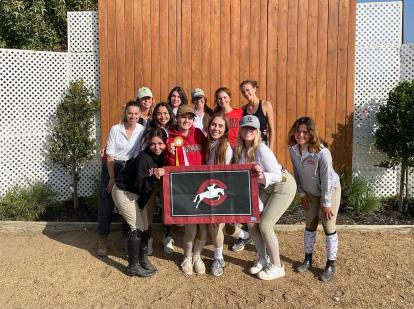
YOU at Chapman is an online mental-wellness program “designed to help students manage stress, set goals, prioritize well-being and connect with appropriate campus resources,” according to the Chapman University newsroom.

Due to increased funding from the Student Government Association, all students will receive access to YOU at Chapman through their enrollment with the university through the 2022-2023 school year.
Alexis Reekie, current Student Government Association President, said that the platform cost approximately $19,000 to launch in November 2021, and an additional $3,145 to continue the program through the following school year.
YOU at Chapman is a customized platform originally designed by an external vendor YOU at College, who creates a mental-wellness website customized for a specific university. A portion of the articles listed on the platform are entirely written and created by the YOU at College team, while others are tailored specifically to Chapman.
The platform is divided into three distinct sections, with the end goal of addressing student’s issues in a well-rounded manner. Students must log into the platform themselves and complete modules relating to three categories: Succeed, Thrive, and Matter.
“Succeed” aims to assist students in academic or career struggles, “Thrive” focuses on physical or mental wellbeing and “Matter” offers suggestions related to social connections within the Chapman community.
“My hope is that it will provide instant and personalized mental wellness resources for Chapman students,” Reekie said, “Student Government Association is constantly looking for ways to support students at Chapman.”
YOU at Chapman is now the contemporary partner to Student Psychological Counseling Services (SPCS) at Chapman University.
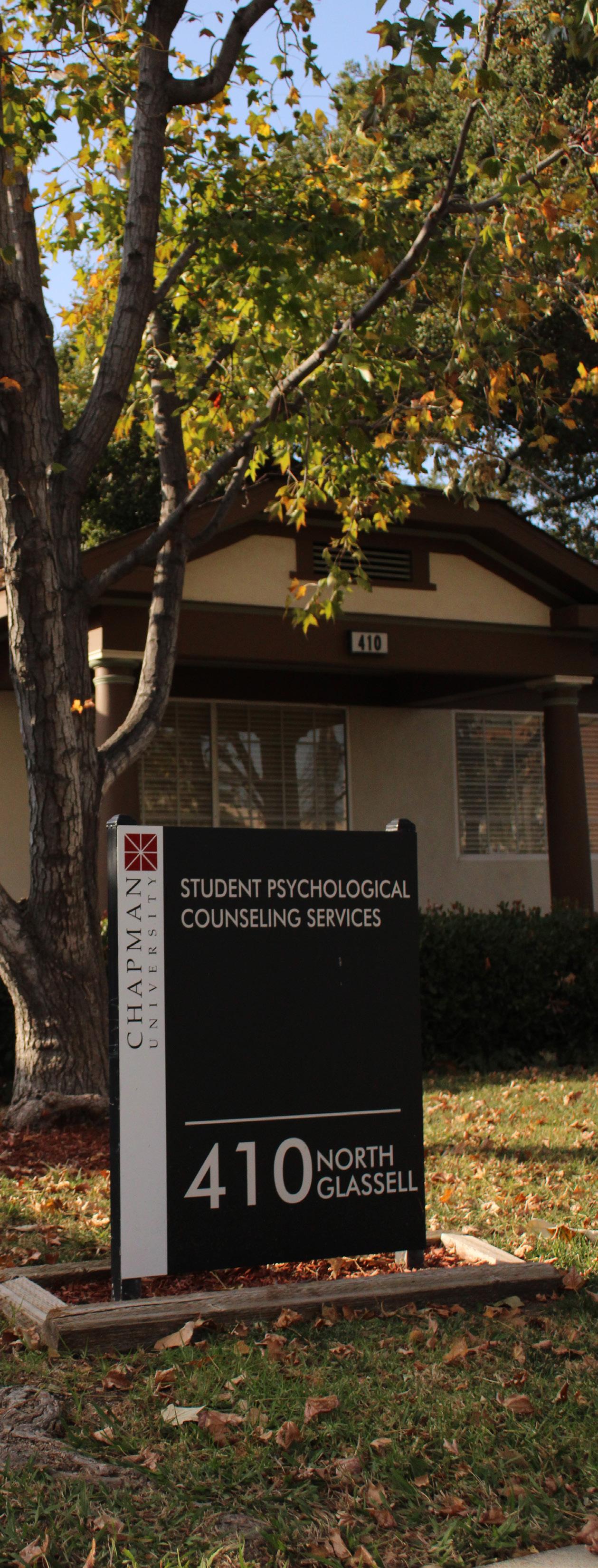
According to Chapman’s resources on SPCS, there are 21 individuals on staff, with positions ranging from director-level positions to interns. In total, there are 7,656 undergraduate and 2,345 graduate students enrolled at Chapman, bringing the total student population to 10,001.
Currently, there are 6 full-time therapists, 1 part-time therapist, and 1 part-time psychiatrist available to serve 10,001 students. While not all 10,001 students are requesting mental health services through the university, mental wellness plummeted globally during the pandemic, subsequently increasing demand
for mental health services. According to a scientific brief released by the World Health Organiza tion, global prevalence of anxiety and depression increased by 25% during the first year of the pan demic.
Students specifically are facing an unprecedented mental health epidemic, even with the pandemic beginning to lull. The 2020-2021 Healthy Minds Study, which surveyed students across 373 college campuses nationwide, found that over 60% of stu dents met criteria for at least one mental health issue. Another student-based study, the National College Health Assessment, found that nearly three quarters of students reported moderate to severe psychological stress.
Andrew Kami, Director of SPCS, said that the center served about “20% to 25% of the student population during the pandemic, an increase from 12-13% of the population before COVID.”

Kami has worked at Chapman since October 2019, right before academia went digital due to concerns over spreading coronavirus.

“The demand rose sharply during that time,” he said, “but there is still a lot of need out there.”
Currently, SPCS is seeing about 15% and 19% of the student population, but Kami notes that not all students requesting care through SPCS desire formal therapy or mental health assistance.
“A good amount of students come to us for things that aren’t quite appropriate,” Kami said, “Some students come to us and request that we write them letters to get out of classes, finals, midterms, parking tickets, to make complaints against administrators.”
Kami feels that students requesting care for inappropriate reasons makes it challenging for SPCS to prioritize students, as each student is vetted and evaluated prior to being invited in. This ultimately delays therapeutic care for students with more serious mental health issues.
“So many students need us for things like grief, loss, anxiety, eating disorders… so to come in because you want a parking pass doesn’t seem quite appropriate,” he said.
Outside of differentiating students in the queue that want to use SPCS for inappropriate reasons and students that have a need for more intensive therapeutic services, Kami noted that SPCS has several under-utilized services outside of one-on-one therapy.
“We have coping skills groups, couples groups, and other programs that students do not utilize,” he said, “no one shows up.”
Additionally, SPCS also has drop-in hours on zoom, a 24-hour call line, yoga and many other resources that students do not use.
SPCS recommends YOU at Chapman as a wellness resource for students, but its predecessor Therapy Assistance Online (TAO), a very similar system that packaged wellness resources into a website for students, had low utilization rates. This has led Kami to feel unsure about whether or not the system can genuinely lessen demand for therapy services at Chapman.
“We tell them to sign up for YOU at Chapman,” he said, “The students are not following through.”
As of mid-November, there was a waitlist of about 50 students for therapy services, according to Kami. Present demand is causing students to wait upwards of three weeks to meet with a therapist.
“We are understaffed for the amount of demand,” Kami said.
Despite the increased need for mental wellness services, Reekie noted that student use of YOU at Chapman has “dipped since its initial launch last school year,” attributing the decrease to a lack of advertising.


121 individual students accessed the platform this semester, according to Justin Koppelman, Director of Student Engagement at Chapman University.
Koppelman could not access any data on gender, ethnicity, race, class standing or other identifiers for the 121 students that have utilized YOU at Chapman in the Fall 2022 semester due to software issues.
fore they feel they need direct, formal oneon-one therapy,” Koppelman said.

He hopes that the platform will alleviate some of the strain currently put on SPCS, and reduce waiting times for students that need formal therapeutic services, but does agree that more can be done in regards to marketing the platform.
Both Kami and Koppelman are part of the Student Affairs Management team at Chapman, which partners with the Wellness and Recreation team to construct the tailored portion of the program.
“The intention of [YOU at Chapman] is to get students easier access to resources that may help them with their mental wellbeing be-
“Students are going to see things when they want to see it,” Koppelman said, “I have no doubt that there is more that can be done to reach more students.”
Furthermore, Koppelman said that Chapman faculty and staff also have access to the platform, and have been encouraged to promote it as a wellness resource to students.


“Students must take the initiative to do it,” Kami said, “This generation of students are experiencing higher levels of anxiety and stress, but they are not doing more for themselves.”
In regards to further expansion of resources to meet student demand, SPCS is developing a peer program, where students would be trained to be a peer-support to meet with students that are experiencing some difficulties. As of mid-November, SPCS has not met with SGA to jumpstart the program.

YOU at Chapman may expand in the coming school years, but there are no plans to expand the platform at this time beyond enhancing marketing efforts to reach more students.
Chapman

new,” Kami said,
To access the resources available at YOU at Chapman, go to you.chapman.edu and create a free account with your Chapman University credentials.

“YOU at
is so
“There are so many resources that students are not taking advantage of.”
“Students must take the initiative to do it...This generation of students are experiencing higher levels of anxiety and stress, but they are not doing more for themselves.”
– Andrew Kami

 By Joel Peterson
By Joel Peterson
Doyle-Ortega, a junior majoring in journalism at Chapman University, relies on her minimum-wage job in order to pay rent and live by campus.
Ortega is not alone.
According to a study done by the National Center of Educational Statistics, the percentage of full-time undergraduate students who were employed was 43%.
“I moved from San Francisco on my own. so when my housing was up I got a room in a house with a couple roommates,” said Ortega.
Due to financial limitations, some Chapman students are unable to achieve a financially dependent collegiate lifestyle and must work their way through. While student loans can help cover tuition until six months post-graduation, expenses such as food, rent and electricity can make living all the more difficult.


Mack Allen, a senior majoring in psychology at Chapman University, works fulltime to be able to live around the general vicinity of campus and attend the university.
“I work in college just to afford living alongside school costs and hobbies/activities,” says Allen.
Allen works for Sodexo and the IS&T department where he averages working 40 hour weeks.
Chapman offers a Federal Work-Study Program which allows students to work on campus part-time while obtaining a degree. To qualify for the program, students have to show a financial need which will allow them to work.
Students who take advantage of the Federal Work-Study Program say they must sacrifice certain aspects of their college experience in order to stay afloat.
“Working the amount that I work has been tough on trying to be social and finding time to do the things I want is hard,” Josh Taylor, a senior majoring in data analytics.
Making new friends and finding employment for life after college is a common goal of many who attend university. However, it is difficult when many students cannot find time for themselves. Working full or part-time to meet basic needs while attending university as a full-time student can present itself with challenges for a person in regard to time management, quality of education and social purpose.
Photo by Joel Peterson“I think I am able to balance everything, but my social life suffers, I’ve found for myself that the key to having balance is to commit to a lack of sleep and still try to fit [in] a full day,” said Allen
It is important for university students to build a work ethic that will be needed in life after college.
Stress can also be a challenge for students who work off campus or take advantage of the Federal Work-Study Program.
“I definitely can’t balance all of them if I want to be truly happy. The financial struggle ends up stressing me out too much,” Ortega said.
Balancing work and full-time school schedules is difficult. Students deal with stress differently. Everyone has different life scenarios, and Chapman does help alleviate some financial stress with grants and scholarships.


Chapman University grants nearly $177 million to undergraduate students averaging $34,000 annually in aid, according to Chapman’s website. Chapman also offers merit scholarships that offer full-ride scholarships on rare occasions.
Chapman offers the Federal Pell Grant to students who have shown that they need financial assistance. Students can apply for this through FAFSA to see if they qualify for
the grant. The amount will be determined based on the students’ financial situation.
To many, college is regarded as the best four years of one’s life. Whether it’s buying a cup of coffee or going to the bars, “having fun in college means spending money so I usually have a hard time having fun and not regretting it after,” Ortega said.
While college can be fun, it doesn’t come without its own problems. Being a college student without much financial prestige is something that many can relate to, and it is difficult to maintain a balanced social, collegiate, and financial lifestyle
“In the long term I couldn’t see myself maintaining this lifestyle as it simply is too much of my time for an unreasonable outcome,” said Allen.
To many, college is the first step into adult life. They are faced with new challenges which may be overwhelming and challenging to deal with. The new lifestyle presents a new bridge to cross and obtaining a degree while working presents an even greater challenge. Finding the right resources will assist people with their needs.
“My work ethic has definitely gotten better. Since I don’t have a lot of time within my day for myself, I’ve definitely learned how to manage my time accordingly. I feel like once I graduate all my hard work will translate into my professional life,” Taylor said.


 by MegHipp
by MegHipp
Whether they’re writing, performing or producing, musicians at Chapman value collaboration.
Who are these musicians?
is a junior majoring in television writing and production and minoring in music business. Lynn has been making music from a young age. Growing up in a musical family, she was constantly surrounded with musical influences. Her dad is a drummer, her mom is a pianist and her siblings play music as
-
(above) well. When she was in middle school, Lynn’s brother helped produce her first song, BOY, which launched her career and led her to pursue music. Coming to Chapman from a STEM focused high school, Lynn noticed the difference in creative opportunities she could have. “I’ve never been in an environment where everyone is so open to making stuff and just being like, ‘Yeah, let’s do this and let’s do that,’” Lynn said. “Everyone has a very strong passion for it, which I think is really cool.”
Lynn says Chapman’s creative environment has pushed her to continue to pursue music. Through The Collective, one of the largest music and arts clubs at Chapman, Lynn has made connections with drummers, producers, guitarists and other bands who play her songs with her live.
The opportunities to perform at Chapman have been an overwhelmingly positive experience for her.
“Having connections is really fun.” Lynn said, “And, aside from it being a busi-
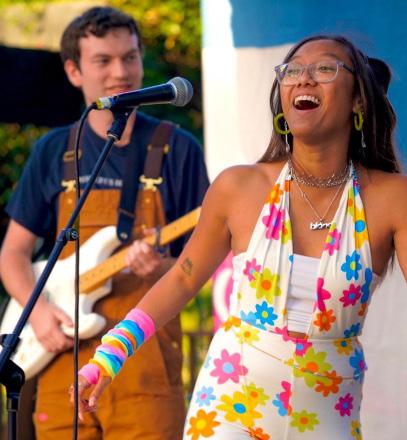
“...This is really what I want to do for the rest of my life.”
Tobey Lynn
ness thing, [it’s] also just having friends that are into the same thing as you.”



Now taking on a music business minor, Lynn is learning more about the industry and relating her schoolwork to her passion for music while continuing to perform. Overall, Lynn has found the opportunities she’s had with music to solidify her hopes for her future. Lynn said, “[I’ve] come into my own and kind of realized, this is really what I want to do for the rest of my life.”
(Above) Tobey Lynn (left) and O-Sky Lochmandy (right) performing at the Flower Moon music festival hosted by Chapman’s music and arts club: The Collective.

Courtesy: Tobey Lynn. (Next page) These spotify codes connect listeners directly with the artists’ music. Scan them in your Spotify app to hear Tobey (Red) and O-Sky (Black and White)



(Top right) The album art of Tobey Lynn’s EP Party of One. (Middle right) O-Sky album art for his album Music from the Past and the Future. (Bottom right) Song art for Tobey Lynn’s most popular song Sunflower.

is a junior majoring in television writing and production. His music journey began over a decade ago; Lochmandy picked up a guitar at age 8 and immediately dove into creating music with support from his family.
To start his career, he began performing at open mics and had a few solo gigs at age 9. In the fifth grade Lochmandy released his first EP, then by age 11, he was performing three-hour sets at flea markets and shows at the House of Blues along with various other venues. “It was just the coolest stuff. [Performing there] was the best,” Lochmandy said.
Prior to college the rest of Lochmandy’s musical experience mostly consisted of working with musicians who had over twenty years of experience in the industry.



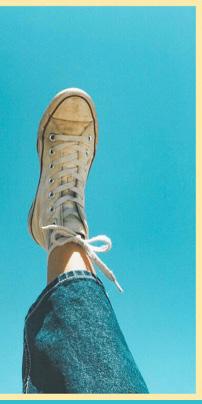





When he came to Chapman, Lochmandy found more opportunities to work with peers after a friend recommended he perform at a Chapman Radio event. From that event, his musical connections multiplied, opening doors for collaboration.
This semester, Lochmandy is focusing on writing music more than performing. He can often be found experimenting with writing comedy songs, learning rap techniques and playing guitar with others--including Lynn.
Being immersed in this creative environment while being in school has provided more opportunities to combine Lochmandy’s passion for music and writing; during the summer he wrote two musicals, one of which was produced in Greece as part of a Dodge College travel course.
“I love music, comedy and writing so much. There’s a big connection between those things,” Lochmandy said. He hopes to pursue anything that combines his passions whether it be performing, or writing behind the scenes. “I think that there’s always going to be that feeling of making a project that I’m excited about.”
Looking beyond college, Lochmandy described his future in three words: “Connect, create, inspire.”
is a senior majoring in television writing and production with minors in law, justice and social control and film music.
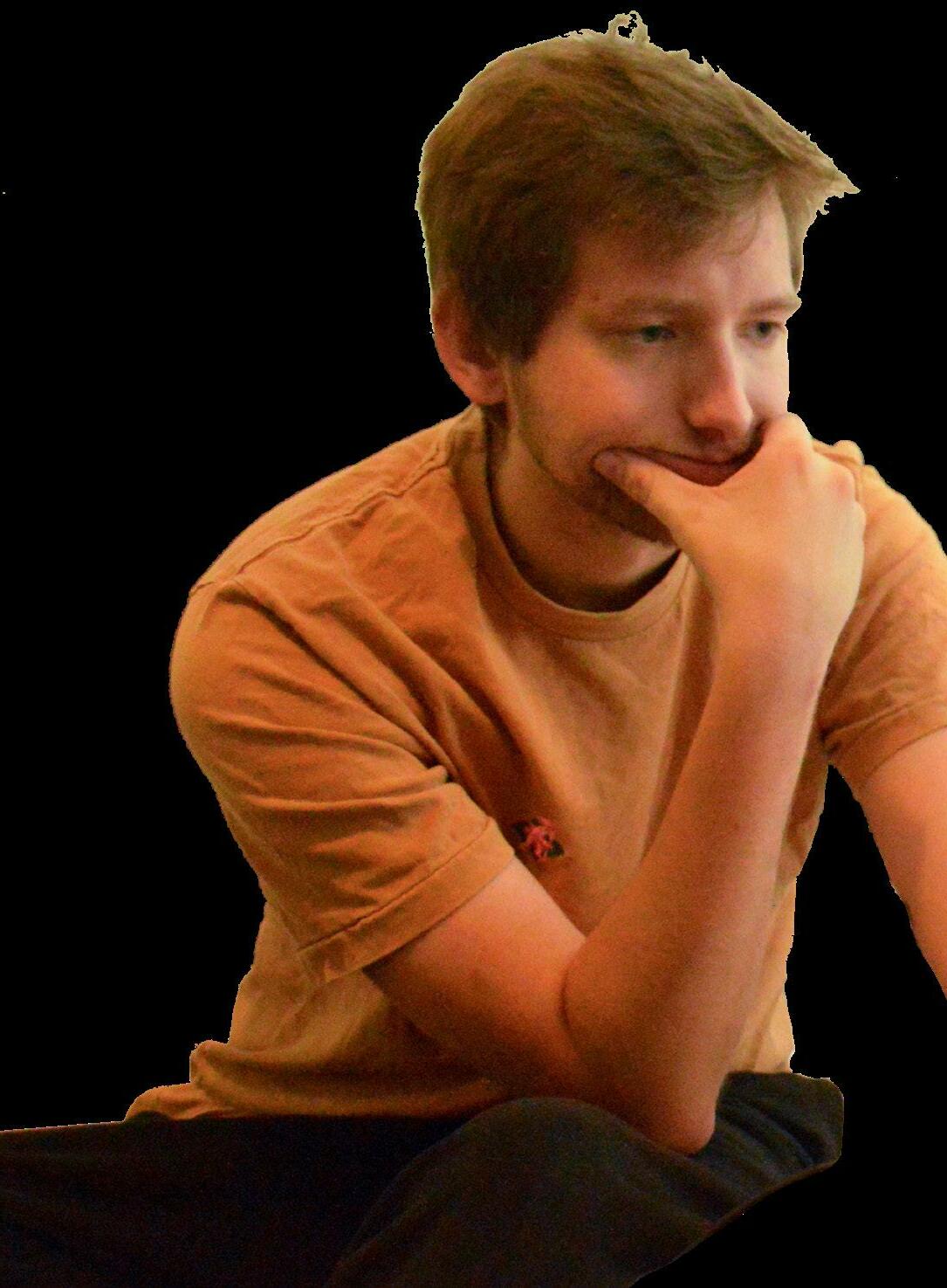
Archerd’s music journey began at age 6 when they first learned classical piano; later they learned other instruments including baritone and trombone. They took their talents to marching band, wind ensemble and pit orchestra throughout elementary, middle and high school. By sophomore year of high school, Archerd began composing music. By junior year, they were creating their own original songs for a short film.
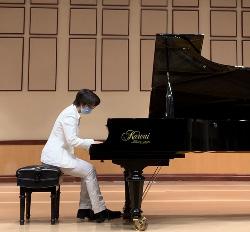
Now in college, Archerd has had the opportunity to create various songs for many projects. In addition to TV writing, Archerd has been writing and composing a musical for over a year. This October, their musical: “The X-tra Files” was brought to life by the Players’ Society, a student-run theater club at Chapman.
To create the musical, Archerd said, “[the director and I] talked about what we wanted the songs to look like in terms of the vibe and basic melodies and some ideas for the lyrics, and then I put it all together.” Next semester Archerd will be fully producing and distributing the cast album for the musical.
Along with writing, Archerd has experience in music production and sound mixing and is always able to help other students produce their projects.
performing piano at Pianists in Recital”
Courtney Archerd.

As part of the sketch-comedy club, Father’s Milk, Archerd continu ously implements music into what they write for shows. Currently they are writing a compilation of three songs with two other people in the club.
“[The other two members] don’t know much about music, but together, we managed to put together the songs, and now I’m gonna produce them for the [show,]” Archerd said.
Archerd is always finding ways to incorporate writing music into what they are working on and hopes to continue to do that in the future as well.
“Whenever I get a chance to flex my ‘musical chops’ for the club, I do, because I feel like a lot of people love it, and it’s just fun for me to try that side of my brain,” said Archerd.
Griffin Jones is a junior majoring in television writing and production with a music technology minor. Similar to Lynn, Jones also comes from a musical family and was mostly influenced by his sister who is a country singer. Jones began creating his own music in his junior year of high school, under the name Grifdorf.
He has since released an EP in a genre he describes as space-funk. He is constantly working on new projects including additional singles and album.
“I grew up in North Carolina with a lot of non-creative people, so it’s kind of cool to be around a bunch of people that are creative all the time and to get to create cool work with them and have fun,” Jones said.
Not only is he making music with friends, Jones also recently launched his own record label: Pajama Punk Media. He represents musicians he knows (including himself) to promote their music and help immerse them in the industry.
“I think the collaborative spirit at Chapman is strong ... everybody’s willing to try something different and experiment.”
-Griffin Jones (left)
Jones is currently working on a collaborative album now and can be found jamming with Lochmandy weekly along with other students.

“I think the collaborative spirit at Chapman is strong and just very much so [that] everybody’s willing to try something different and experiment,” said Jones.
In his final year and a half, Jones is continuing to build his repertoire and is hoping to see his music take off.
His main goal for his music is “to just make somebody’s day better or make somebody a little bit happier or understand whatever they need to do, you know and if I could do that just through music, I feel like that would be really cool,” said Jones.
Chapman students are fostering their own creative and collaborative environment to support one-another in exploring their passions for music. Students like Lynn, Archerd, Lochmandy and Jones came to Chapman from various musical backgrounds with different skill-sets; at the forefront of their minds is a desire to create music with one another and be immersed in the community of creatives at Chapman.
“There’s so many people who are just around and ready to make stuff,” Lochmandy said. “We really all just have such different histories, and then you come together and you make something and it’s like ‘wait, what was that that you just did?’ I’ve never seen that before…”
This community of musicians encourages constant learning within their collaboration, opening more doors for them to grow as artists.
(Left) Courtney Archerd (left) and O-Sky Lochmandy (right) in front of Dodge College after the premiere of three films created as part of the Dodge College Greece travel course which featured music written and produced by them. Courtesy: O-Sky Lochmandy.
Open your Spotify app and click the camera icon next to the search bar and scan the codes under the images to listen to these artists’ music!
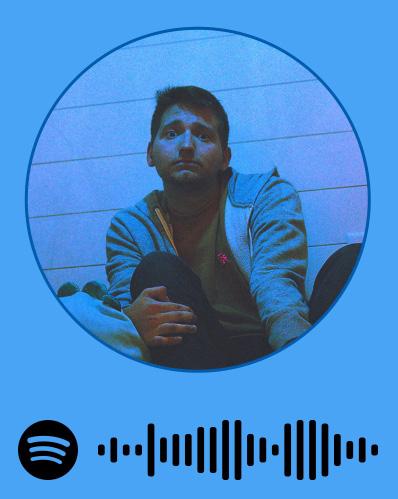

(Music from The X-tra Files by Courtney Archerd should be available in 2023. Check @chapmantps on Instagram for updates!)

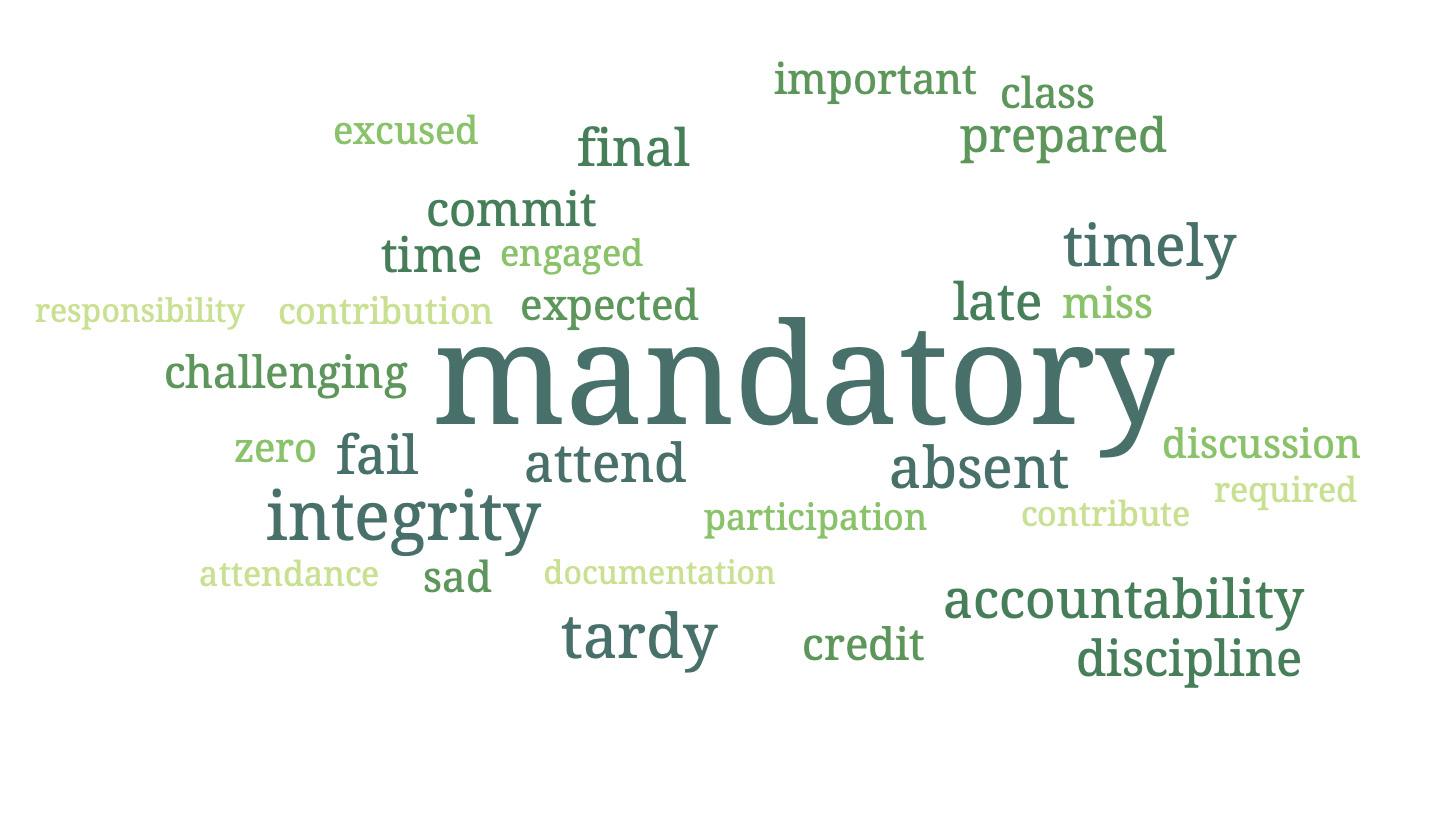

Chapman student Susie found her head in a toilet, just two hours before her statistics class.
“Bad timing for the stomach flu,” she thought.
She did what any person who was ill would do -
The next day, she learned
Although the recommended Chapman University attendance policy states that students who do not go to class for 20% of the semester should fail the course, professors and members of faculty have the freedom to implement their own policy.
“Professors are in charge of the class, period,” said Liz Sanchez, a member of Chapman’s adjunct faculty teaching LGBTQIA+ Studies and Transformative Justice.
Sanchez, who goes by they/them pronouns, stated that though their attendance policy allows for four absences throughout a 16-week semester, they are “not a dictator over it.”
Sanchez clarifies that a majority of their students show up to class.
“We are learning about exciting subjects taught in a manner that is relatable and real,” said Sanchez, “I focus on making it a safe space and having students want to come to class.”
Despite Sanchez’s views regarding their attendance policy, not all professors share the same beliefs.
Absences: A student who is not present within the first 15 minutes of class, or leaves before class is finished without an excuse approved by the instructor before the class starts, will be marked absent. Excused absences must be requested before the absence. One unexcused absence is allowed per semester. Two unexcused absences will most likely mean a no-pass grade for the class. An excused absence, for example, requires a note from the health center or a doctor. Emailing the professor to say you do not feel well, have work to do for another class or have another engagement is not grounds for an excused absence.
Some professors and adjunct faculty require students to obtain a note from a doctor or the health center in order to receive an excused absence.
However, not all students agree with these professors. Isabella Luanava, a junior psychology major, discussed her distaste for attendance policies that require health notes.
“Going to a doctor’s office for a cold is expensive, and most college students can’t afford to get a doctor’s note because they have a fever or feel ill,” said Luanava “it makes it so that students are either not going to classes because they’re ill and getting penalized for it, or they go to class and make other people sick.”
“I do believe that as long as the regular illness is clear and it does not long term impact the work being produced by a student, there is the little base to punish a student who is unable to attend class but may be keeping up all the same,” said Blake Huntley, a senior technology major “This one-size-fits-all policy may not have wiggle room for both extenuating circumstances.”
A current faculty member has the following attendance policy written on his syllabus:
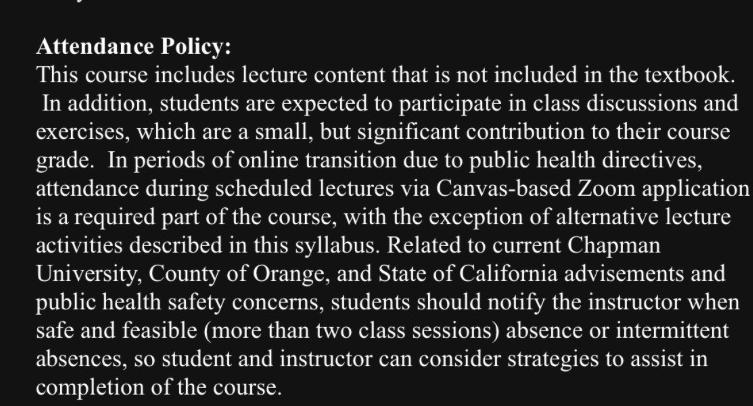

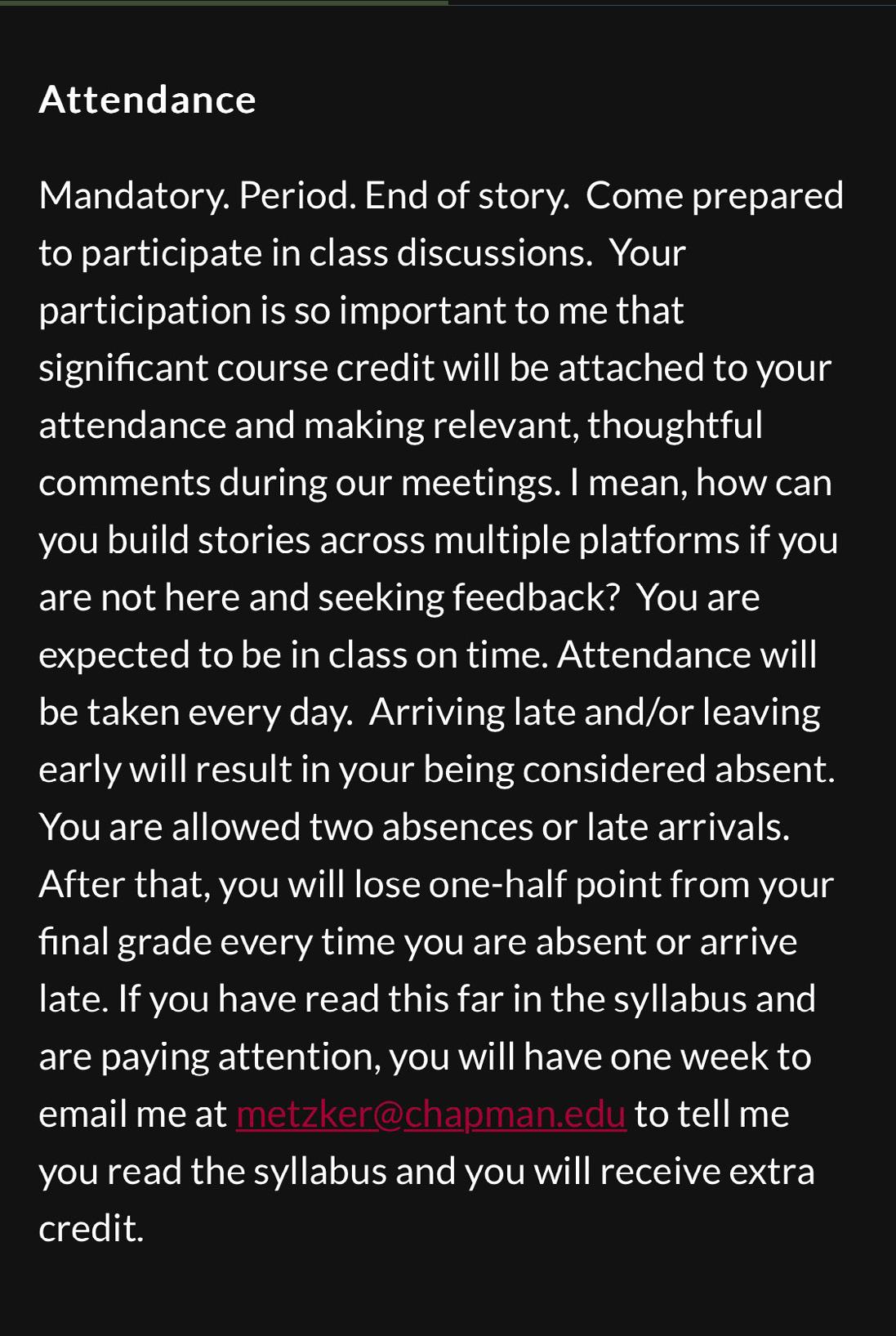
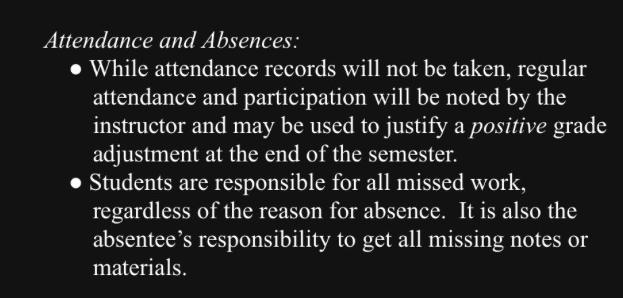



Nora Rivera, an assistant professor in the English department, stated that even though she has a for credit attendance policy to incentivise students to come to class, she tries her best to be understanding for various circumstances.
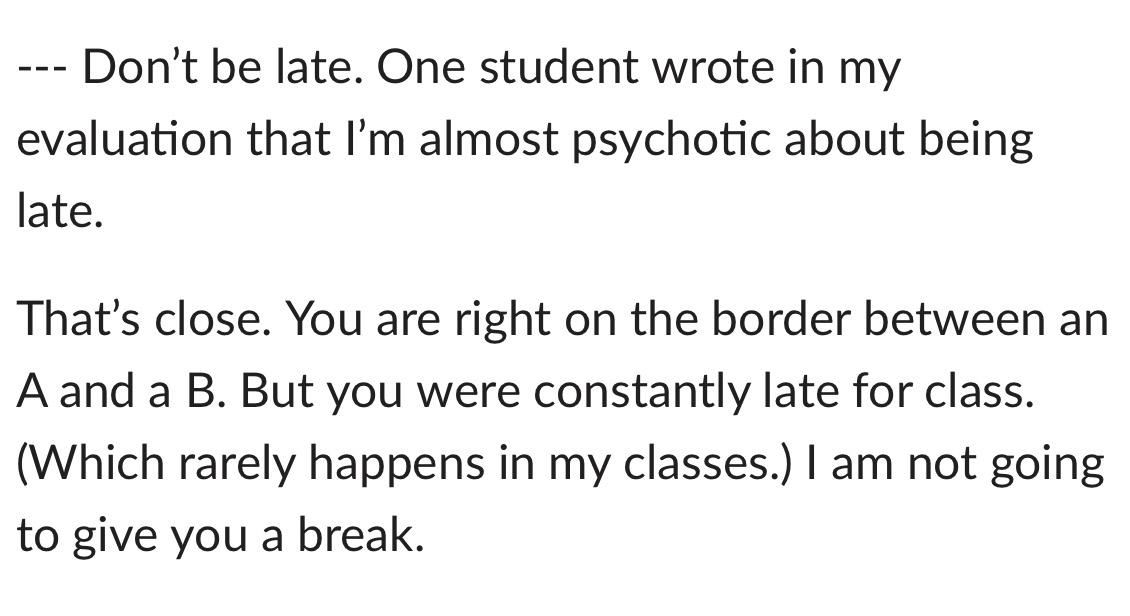
“Excused absence for me is if students are ill, I don’t want them to feel like they have to go because they don’t want to lose the points if they are not feeling well,” said Rivera.
However, Rivera added that if a student is consistently absent, “I would probably ask for a doctor’s note.”

Some attendance policies created by professors only mention what would happen to a student’s grades if they were sick, but not all student absences deal with illness.
Sanchez stated that they do not ask for reasons when a student misses class.
“It’s like asking students to prove to me your trauma,” said Sanchez, “ I believe them, you don’t even have to tell me. I don’t want you to have to feel like you have to prove something to me because of a grade.”
Some students formulated their own opinions on what aspects make up an effective attendance policy compared to an ineffective policy.
“I believe that the 1, 2, and 3 absence policy is effective in classes that require participation and active engagement from students. I do believe that lectures require their system to keep track of this, as these formats are largely in the hands of students to keep up with the content of the course,” Huntley said.
When discussing the “1, 2, and 3 absence policy”, Huntley refers to the policy that corresponds to the number of unexcused absences a student is allowed to have based on the number of days that a class meets per week. For instance, if a class only meets once per week, a student would only be allowed one unexcused absence for the semester.
Carissa Nelson, a junior business major, had different thoughts.

“While it may be an effective approach to ensuring attendance, attendance policies like the one recommended by the university, will not guarantee participation. I believe professors should do their best to make students feel comfortable in their class and do group work to encourage participation,” said Nelson.
Despite having room for flexibility in their policies, both Sanchez and Rivera added that there will always be room for improvement in their attendance requirements.
“I think that maybe some more clear guidelines about what is an excused or unexcused absence could be helpful for both students and I,” Rivera said.
“I slack off on the attendance sheet because I start recognizing students,” said Sanchez “But structurally and technically speaking, I need to approve my attendance policy.”
However, Sanchez clarifies that they will not go along with the university’s recommended policy or ask for notes from doctors because “it sends a message to students that they are liars, and I trust my students.”
“Faculty can adapt,” emphasized Sanchez, “I just want to help students make a change for the positive.”
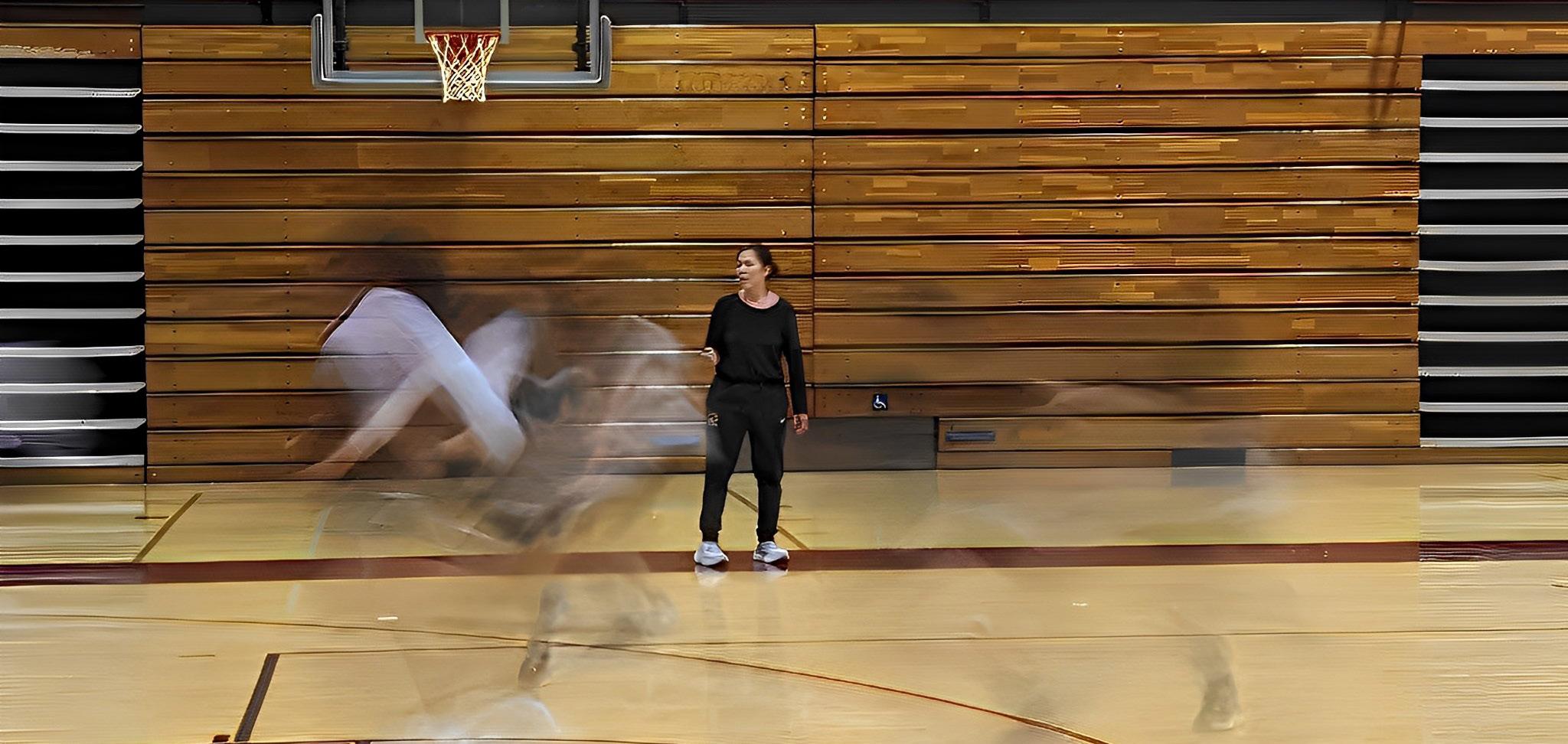 By Sofie Kassaras
Carol Jue Shoots for Success with the Women’s Basketball Team
By Sofie Kassaras
Carol Jue Shoots for Success with the Women’s Basketball Team
Tucked underneath the Argyros Fitness Center is Chapman University’s gym. Most nights during the winter, you can hear the rhythmic squeak of sneakers against the wood floors.
Above that, you hear the commanding voice of the women’s basketball
 Carol Jue stands courtside as her players conduct drills during practice. Photo courtesy of Sofie Kassaras.
Carol Jue stands courtside as her players conduct drills during practice. Photo courtesy of Sofie Kassaras.
Coach Carol Jue.
Coming upon her 20th year coaching the team, Chapman University heralds Jue as the “winningest” women’s basketball coach. With over 300 wins and an impressive rapport of finals campaigns with The Southern California Intercollegiate Athletic Conference, or SCIAC.
Underneath all the statistics, however, is a passionate woman with a lifelong love for basketball.
At just two years old, Jue recalled watching her father play basketball with their neighbors, which caught her fascination. At ten, she began playing the game herself.
“I would just play with the boys at lunch and nutrition and after school,” Jue said. This early exposure gave her what she described as “an itch” to play. She participated in basketball all throughout junior high, high school, and college at California State University, Los Angeles. During her time there, she would also coach basketball at her local high school, Montebello.
She would later graduate from Claremont McKenna College with a degree in economics and accounting. She worked in accounting during the day while coaching at Montebello at night, but ultimately chose to dedicate all of her time to coaching basketball.

“One day, I turned to my husband, and went: can I coach? Can I do this?” Jue said. She would continue to coach through the 90s, before joining Chapman’s staff in 2003. Since then, the trajectory of the women’s basketball team scores have skyrocketed, according to her university bio.
Jue’s coaching style is revolutionary, and she is also a trailblazer in the NCAA coaching scene. Until recently, Jue was the only Asian-American head coach for women’s basketball in the National Collegiate Athletic Association, until Pomona College hired Alana Woo in 2019. Before that, Jue found the title extremely surprising.
“The first time, [I] was like, ‘no, really?’...” said Jue. “When I was the only one, I didn’t believe it, and I didn’t think it was a big deal.”
 Photo courtesy of Kassaras.
Photo courtesy of Kassaras.
Although she did not think the title was significant, senior applied human physiology major Jamie Kwong had always looked up to Jue from a young age.
“Growing up in the Asian-American basketball community here in Southern California, I looked up to Coach Jue way before my years of playing,” Kwong, who played on the team for three years, said. “She displayed a style of play that defeated the status quo.”
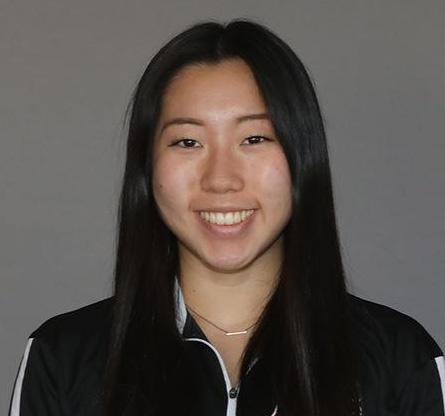

While Kwong was the shortest player on the team, standing at 5’3, Jue found a way to make height an advantage.
“Height can be a major disadvantage in any sport. But [Jue’s] style of play was fast-paced, smart, and aggressive on defense, so being the shortest team in SCIAC did not matter very much. We would play full-court defense and push the ball up the court on offense, which worked in our favor when we got a steal or missed rebound.” Kwong said.
Senior Jamie Kwong heralds coach Jue as a pivotal role model in the Asian American basketball community. Photo courtesy of Jamie Kwong.Junior Katie Kubo considers Jue’s coaching method as “tough love” and appreciates her contribution to the basketball community. Photo courtesy of Kassaras.

Junior psychology major Katie Kubo feels similarly about Jue’s accomplishments.
“It is really inspiring to see s omeone from our community be so successful and have such an impact on women’s basketball,” Kubo said. She has been playing on the team her entire time at Chapman.
Perhaps the most compelling aspect of Carol Jue, however, is her aggressive coaching style.
“At practice, I’m in the nitty gritty, I’m almost in their faces. I’m talking the whole time,” Jue said. “It’s my theater. It’s my church. I talk about hustle, I talk about effort.”
While much of her feedback can come across as overwhelming, Jue said that she tries to instill life lessons in her players.
“I’m always talking…it’s a lot of teaching and a lot of yelling and sometimes, [the team is] probably like ‘this lady’s crazy.’ But, if you can endure my yelling and you can endure all this running, you can endure anything.”
The most important part of coaching to her is focusing on how to improve not only the individual players, but how they work in a team environment. Although she dislikes losing, she sees it as an opportunity to grow.
Kubo agreed that Jue’s coaching methods were intense, but described it as “tough love.”
“Her coaching methods are a big part of the team’s successes. She pushes her players to be the best that they can be both on and off the court,” Kubo said.
Kwong, who no longer plays for the basketball team, feels similarly about Jue, but also noted her sweeter, caring side. “Coach Jue can be the most obnoxious and constructive critic on the court, but off the court, she’s one of the kindest individuals I know… [She’s] always giving and looking out for everyone that’s a part of her team. That’s why, even when she would be screaming her head off at me, I would put thicker skin on.”
Jue expressed similar fondness for her team, stating that she strives to see them succeed, even if they have doubts, “I have confidence in you but you’ve got to have confidence back.”
With the 2022-23 basketball season starting to take off, the majority of practices center around specific strategies for success. Underneath all the yelling and drills, however, lies a true passion for teamwork, personal growth, and, of course, basketball.
“Every time I step on the court, I want to win,” Jue said. “It’s hard, because we’re all afraid to mess up. But, if you don’t mess up, you don’t get better.”
 Carol Jue thinks that her in-your-face coaching style instills life lessons in her team. Photos courtesy of Kassaras.
Carol Jue thinks that her in-your-face coaching style instills life lessons in her team. Photos courtesy of Kassaras.
Kristen Doorn, a professor in the Attallah College of Educational Studies, uses a variety of assignments in order to help her students think more critically about the literature they include in their curriculum.


Heather Alvarez, a senior Integrated Educational Studies (IES) major at Chapman, never thought about going into teaching until she participated in the Teacher Education Academy at Century High School (TEACH Academy program) in Santa Ana.
Participating in the program that had high schoolers tutor at local elementary schools and volunteer at after-school programs allowed her love for teaching little kids to foster.
nor, a Science Technology Engineering Math (STEM) Education minor and a Leadership Studies (LEAD) minor.
Another degree option for Attallah students is the MA in Curriculum and Instruction (MACI) program, which lets students graduate with a bachelor’s, master of arts and two California teaching credentials in five years as long as they are enrolled full-time.
For IES and MACI students, Attallah College has partnerships with other districts as well, including SAUSD and the Anaheim Elementary School District.

“I always had patience with little kids, and when I’m [with them] I feel like a leader; everywhere else, I’m a follower,” Alvarez said.
The IES major is just one of the undergraduate programs that Attallah offers to prepare students for their teaching careers, and in recent years, education has been undergoing several changes. Alvarez is currently enrolled in the major’s “schools” emphasis and the literature and literacy minor. IES majors can choose between the “schools” emphasis, which is meant for students who want to work as a K-12 teacher or school counselor, or the “community” emphasis, which is intended for those who want to work in a charitable organization or run an arts studio.
Aside from the IES major and literature and literacy minor, Attallah also offers an IES minor as well as a secondary education mi-
Throughout their time in Attallah, students can expect to engage in some of the discussions currently being held among educators, one of which is ethnic studies. This subject is discussed in the literature and literacy for children and adolescents class. In recent years, desire for an ethnic studies curriculum to be taught nationwide in K-12 schools has become a heated topic between educators, officials and parents.
This ultimately culminated in the statewide ethnic studies requirement, which was signed into law in 2020 by Gov. Gavin Newsom in the form of Assembly Bill 101. In this law, high school students will be required to take a semester-long ethnic studies course as part of the graduation requirements starting with the graduating class of 2029-30. High schools must begin offering courses by the 2025-26 school year.
Ethnic studies is defined as “the interdisciplinary study of race, ethnicity and other identities, focusing on people’s lived experiences and perspectives,” according to the California 100 Platform, an initiative created by the University of California and Stanford University to research and support initiatives and policies that could potentially help California move towards an “equitable, healthy and sustainable future.”
Years before this requirement was approved by Newsom, Santa Ana Unified School District had already been working to integrate ethnic studies into their classroom. While they unanimously passed a resolution to make ethnic studies a mandatory graduation requirement for high school students back in 2020, they have offered courses throughout the district since 2015, according to a Voice of OC article.
Through the literature and literacy class, students learn how to engage children and young adults with an ethnically and culturally diverse selection of literature through assignments such as an annotated bibliography. There is also a final free choice project where students can pick among several options, including designing and describing their own classroom library, writing a paper on a children or adolescent author or creating a picture book.
adolescents in a way that is meaningful to them,” Attallah staff member Kristen Doorn explained. ”Voice and choice are key in this assignment, and that makes it meaningful to students!”
Doorn, who has been teaching the class for eight years, strongly believes in using a culturally responsive framework, which seeks to incorporate racial/ethnic, gender and sexual orientation identities, among others, into classroom curriculum.

“I encourage students to understand that books must be representative of the children and young adults they work [with] in their lives, but also provide opportunities beyond their own perspectives, allowing them to grow and develop,” Doorn said. “Thus, books that are multicultural, from a very broad perspective, are important to young readers.”
“Students get to choose how they’d like to show their knowledge and understanding of literature and literacy for children and
A year after the ethnic studies requirement was signed into law, the state made a major change to its budget regarding the number of tests teachers had to take in order to get their teaching credential. Prior to the change, aspiring teachers in California had to take four tests, including the California Basic Skills Test (CBEST) that tests reading, writing and math skills and the California Subject Matter Exams for Teachers (CSET) that tests a candidate’s knowledge of the subject they wish to teach. Teachers are no longer required to take either of these two tests as long as they complete approved coursework.

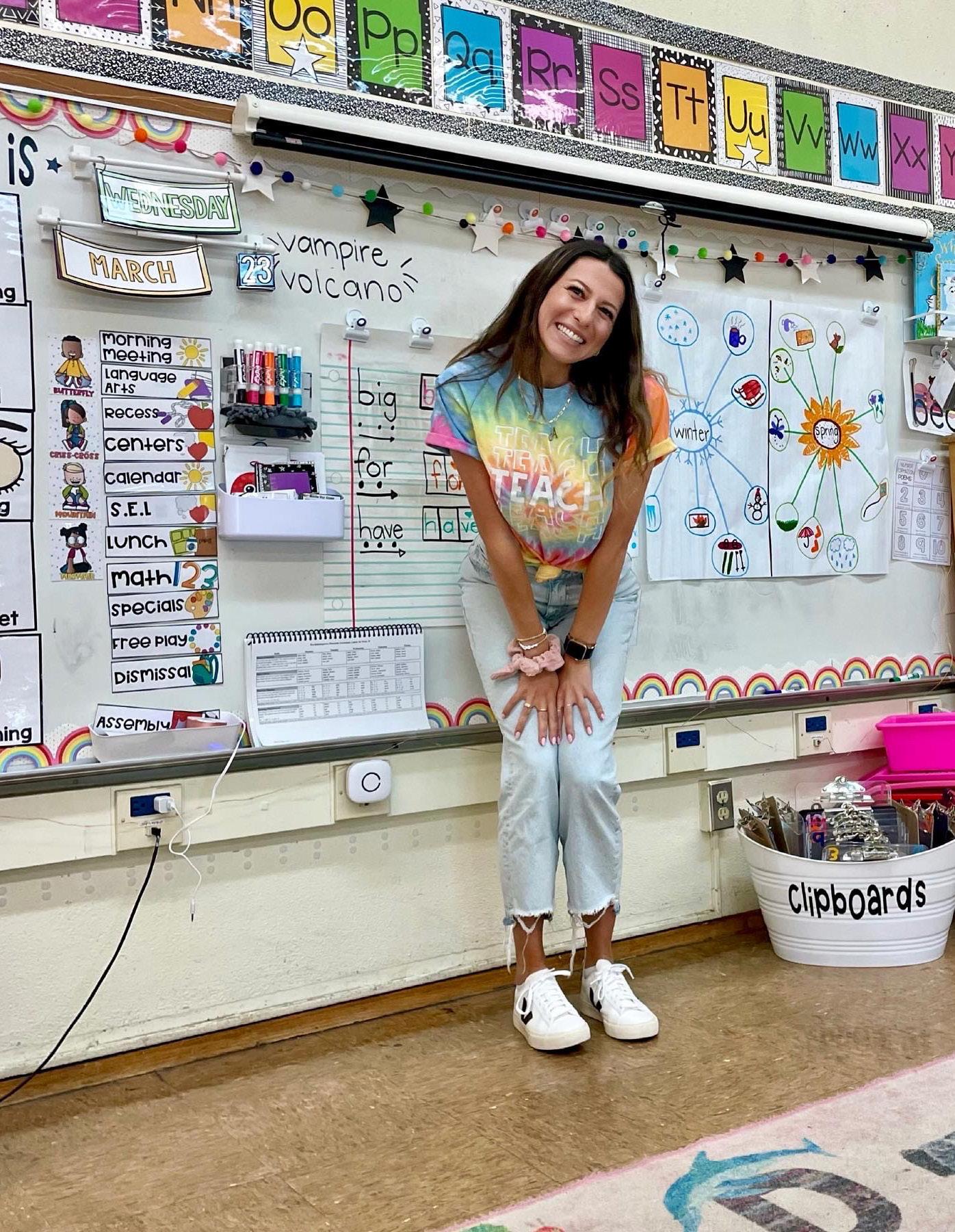
“Fair Shares” chronicles the journey of Bear and Hare, who start out trying to reach some pears and learn about how equality doesn’t always equate to fairness. Photo courtesy of Kane Miller EDC Publishing.
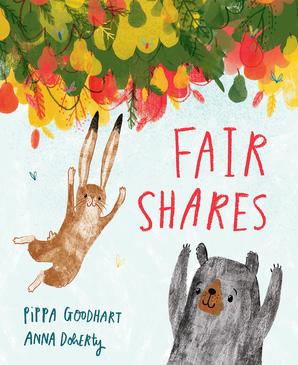
“Fair Shares” chronicles the journey of Bear and Hare, who start out trying to reach some pears and learn about how equality doesn’t always equate to fairness. Photo courtesy of Kane Miller EDC Publishing

Also emerging as a development is the U.S. Bureau of Labor Statistics’ estimate of 77,900 job openings for high school teachers annually over the next decade, as stated by their Occupational Outlook Handbook. According to an article by Education Week, there are currently over 3.6 million teachers and over 1 million teaching assistants employed in the U.S. as of May 2021.
There have also been low testing scores that have been reported since the schools began reopening after the COVID-19 pandemic forced them to close.
comparison, other college graduates found that their wages increased by $445 within those 25 years.
Alvarez explained that her “in” to approaching the younger students she’s worked with is to use sarcasm and talk to her students like they are little adults.
The Nation’s Report Card found that in their National Assessment of Educational Progress (NAEP) Reading and Math Assessments for 2022, the scores of fourth and eighth graders for reading were recorded at 217 and 260, respectively. Fourth graders for math scored 236, while eighth graders scored 274. In 2019, the reading score was 241 and the math score was 220asq. The 2022 scores brought them back to where they were recorded at in 1992.
The scores since 1992 had fluctuated but faced a gradual increase up until 2020 when the pandemic struck.
The controversy surrounding teacher pay is another discussion being held between school officials and teachers. According to the Economic Policy Institute in their August 2022 report, the average weekly wages from 1996 to 2021 for public school teachers that had been adjusted for inflation increased by only $29 within this timespan. In
“I don’t come in like ‘I’m the door, I’m the authority here.’ I come in like ‘I see you as an equal. Let’s talk about it. Let’s go through this,’ Alverez said. “I think they feel comfortable in the end, so I just try to talk to them as little adults. That’s what they are: they’re growing, they’re learning, they don’t need you to babysit them and baby-talk back to them. They just genuinely learn from engaging in conversation with you.”
She wants to teach elementary school, and the main thing she wants to focus on with her students is what they leave knowing.

“A lot of the kids go home and their parents ask them ‘What did you do today?’ [and the kids say] ‘I don’t know,” Alvarez said. “I want to put all my efforts in at least the little kids leaving the classroom remembering what we did…There’s something called an exit ticket, and I always want them to [think about] ‘what I learned today’ and ‘this is going to be important for me later on because blah blah blah.”

As she designs her curriculum based on standards set by the state and school district boards, she would like to employ hands-on visual learning into her classrooms but also have oral presentations so that they learn how to express themselves.
“Whenever I try to do curriculum, I’m like ‘Okay, is this going to be engaging for them to remember when they need to remember it?’” Alvarez said.
For Warner Avenue Elementary School kindergarten teacher Alyssa Kaplan, who graduated from Chapman’s MACI program in 2020, she has placed her focus on introducing her young students to diversity through books that feature diverse characters.
“It’s usually through books that specifically touch upon the ideas of welcoming all and celebrating all and letting the book tell a story,” Kaplan said. “Kids get to see people from all different walks of life.”
One of her favorite books is “Fair Shares” by Pippa Goodhart and Anna Doherty, a book that teaches the idea that fairness doesn’t mean equality.
“When you have such a diverse class with unique needs, people need different things to be successful and to learn, and I think that [“Fair Shares”] does a really wonderful job of opening kids’ eyes to that idea because kids think that fair means everyone gets the same,” Kaplan said. “That starts a really awesome conversation right away at the beginning of school.”
While at Attallah: “We were introduced to a lot of responsive classroom practices with language to use with students,” Kaplan said. “We had great classes on how to work with students who have special needs and [the] support and accommodation that we can provide for students.”
Her thoughts on the student teaching and observation opportunities Attallah offers, the former of which was “the best part” of the MACI program? “Really getting to be in the classroom every single day and teach alongside somebody, you learn so much from your mentor, but you also get to really practice being a teacher every single day for an entire school.”
Kaplan is excited to be part of the new generation of teachers who have entered the field, and she feels “very lucky” to be part of a career that teaches kids how to succeed academically, build character and strive to make the world a better place.
“Being so lucky to teach kindergarten, a lot of times, these ideas that we talk about are so new to them and I get to open [kids’] eyes to the idea of diversity and what it means to be unique, learning to celebrate our differences and what it means to treat people with kindness,” Kaplan said.
While Alvarez is also excited to be entering the field, she is very nervous about experiencing pushback from parents when it comes to having a diverse and inclusive curriculum in her classroom, and she is concerned about the pay issues for teachers.

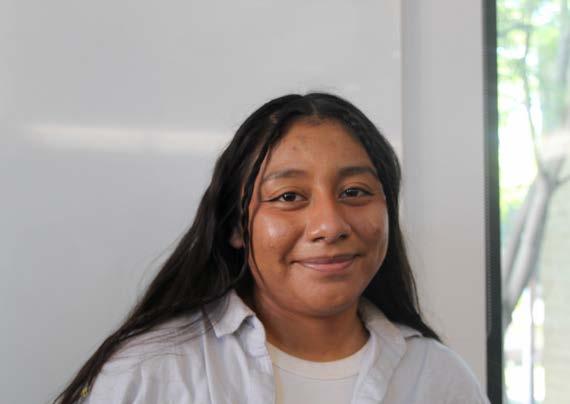
“I’m very nervous ‘cause I love all the books that are coming out [and] include being inclusive … [and] I want to include all of it,” Alvarez said. “But what I’m more nervous about is the pushback from parents and some faculty that don’t believe in those certain beliefs. I will stand my ground at all times, but if I fear that my job will be taken away because I’m not following these roles.”
Alvarez also feels that as much as she likes that Attallah prepares students by encouraging them to “have a voice” and have some confidence and some research to back up their views, she wishes they would also discuss burnout caused by school boards and administrations.
“It’s mostly just teaching, teaching, teaching, and I feel like that should be changed because these school boards are technically our bosses if we go into teaching, so it would be nice to know how our bosses work [and] why they get to choose certain aspects [of the curriculum].”
Heather Alvarez, a senior IES major, hopes to teach elementary school students after graduating from Chapman. Photo by Renee Elefante Cover photo provided by
Ashleigh Magnus Photography
Cover photo provided by
Ashleigh Magnus Photography